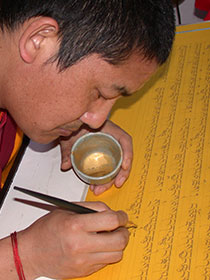- Home
- FPMT Homepage

Foundation for the Preservation of the Mahayana Tradition
The FPMT is an organization devoted to preserving and spreading Mahayana Buddhism worldwide by creating opportunities to listen, reflect, meditate, practice and actualize the unmistaken teachings of the Buddha and based on that experience spreading the Dharma to sentient beings. We provide integrated education through which people’s minds and hearts can be transformed into their highest potential for the benefit of others, inspired by an attitude of universal responsibility and service. We are committed to creating harmonious environments and helping all beings develop their full potential of infinite wisdom and compassion. Our organization is based on the Buddhist tradition of Lama Tsongkhapa of Tibet as taught to us by our founders Lama Thubten Yeshe and Lama Thubten Zopa Rinpoche.
- Willkommen
Die Stiftung zur Erhaltung der Mahayana Tradition (FPMT) ist eine Organisation, die sich weltweit für die Erhaltung und Verbreitung des Mahayana-Buddhismus einsetzt, indem sie Möglichkeiten schafft, den makellosen Lehren des Buddha zuzuhören, über sie zur reflektieren und zu meditieren und auf der Grundlage dieser Erfahrung das Dharma unter den Lebewesen zu verbreiten.
Wir bieten integrierte Schulungswege an, durch denen der Geist und das Herz der Menschen in ihr höchstes Potential verwandelt werden zum Wohl der anderen – inspiriert durch eine Haltung der universellen Verantwortung und dem Wunsch zu dienen. Wir haben uns verpflichtet, harmonische Umgebungen zu schaffen und allen Wesen zu helfen, ihr volles Potenzial unendlicher Weisheit und grenzenlosen Mitgefühls zu verwirklichen.
Unsere Organisation basiert auf der buddhistischen Tradition von Lama Tsongkhapa von Tibet, so wie sie uns von unseren Gründern Lama Thubten Yeshe und Lama Thubten Zopa Rinpoche gelehrt wird.
- Bienvenidos
La Fundación para la preservación de la tradición Mahayana (FPMT) es una organización que se dedica a preservar y difundir el budismo Mahayana en todo el mundo, creando oportunidades para escuchar, reflexionar, meditar, practicar y actualizar las enseñanzas inconfundibles de Buda y en base a esa experiencia difundir el Dharma a los seres.
Proporcionamos una educación integrada a través de la cual las mentes y los corazones de las personas se pueden transformar en su mayor potencial para el beneficio de los demás, inspirados por una actitud de responsabilidad y servicio universales. Estamos comprometidos a crear ambientes armoniosos y ayudar a todos los seres a desarrollar todo su potencial de infinita sabiduría y compasión.
Nuestra organización se basa en la tradición budista de Lama Tsongkhapa del Tíbet como nos lo enseñaron nuestros fundadores Lama Thubten Yeshe y Lama Zopa Rinpoche.
A continuación puede ver una lista de los centros y sus páginas web en su lengua preferida.
- Bienvenue
L’organisation de la FPMT a pour vocation la préservation et la diffusion du bouddhisme du mahayana dans le monde entier. Elle offre l’opportunité d’écouter, de réfléchir, de méditer, de pratiquer et de réaliser les enseignements excellents du Bouddha, pour ensuite transmettre le Dharma à tous les êtres. Nous proposons une formation intégrée grâce à laquelle le cœur et l’esprit de chacun peuvent accomplir leur potentiel le plus élevé pour le bien d’autrui, inspirés par le sens du service et une responsabilité universelle. Nous nous engageons à créer un environnement harmonieux et à aider tous les êtres à épanouir leur potentiel illimité de compassion et de sagesse. Notre organisation s’appuie sur la tradition guéloukpa de Lama Tsongkhapa du Tibet, telle qu’elle a été enseignée par nos fondateurs Lama Thoubtèn Yéshé et Lama Zopa Rinpoché.
Visitez le site de notre Editions Mahayana pour les traductions, conseils et nouvelles du Bureau international en français.
Voici une liste de centres et de leurs sites dans votre langue préférée
- Benvenuto
L’FPMT è un organizzazione il cui scopo è preservare e diffondere il Buddhismo Mahayana nel mondo, creando occasioni di ascolto, riflessione, meditazione e pratica dei perfetti insegnamenti del Buddha, al fine di attualizzare e diffondere il Dharma fra tutti gli esseri senzienti.
Offriamo un’educazione integrata, che può trasformare la mente e i cuori delle persone nel loro massimo potenziale, per il beneficio di tutti gli esseri, ispirati da un’attitudine di responsabilità universale e di servizio.
Il nostro obiettivo è quello di creare contesti armoniosi e aiutare tutti gli esseri a sviluppare in modo completo le proprie potenzialità di infinita saggezza e compassione.
La nostra organizzazione si basa sulla tradizione buddhista di Lama Tsongkhapa del Tibet, così come ci è stata insegnata dai nostri fondatori Lama Thubten Yeshe e Lama Zopa Rinpoche.
Di seguito potete trovare un elenco dei centri e dei loro siti nella lingua da voi prescelta.
- 欢迎 / 歡迎
简体中文
“护持大乘法脉基金会”( 英文简称:FPMT。全名:Foundation for the Preservation of the Mahayana Tradition) 是一个致力于护持和弘扬大乘佛法的国际佛教组织。我们提供听闻,思维,禅修,修行和实证佛陀无误教法的机会,以便让一切众生都能够享受佛法的指引和滋润。
我们全力创造和谐融洽的环境, 为人们提供解行并重的完整佛法教育,以便启发内在的环宇悲心及责任心,并开发内心所蕴藏的巨大潜能 — 无限的智慧与悲心 — 以便利益和服务一切有情。
FPMT的创办人是图腾耶喜喇嘛和喇嘛梭巴仁波切。我们所修习的是由两位上师所教导的,西藏喀巴大师的佛法传承。
繁體中文
護持大乘法脈基金會”( 英文簡稱:FPMT。全名:Found
ation for the Preservation of the Mahayana Tradition ) 是一個致力於護持和弘揚大乘佛法的國際佛教組織。我們提供聽聞, 思維,禪修,修行和實證佛陀無誤教法的機會,以便讓一切眾生都能 夠享受佛法的指引和滋潤。 我們全力創造和諧融洽的環境,
為人們提供解行並重的完整佛法教育,以便啟發內在的環宇悲心及責 任心,並開發內心所蘊藏的巨大潛能 — 無限的智慧與悲心 – – 以便利益和服務一切有情。 FPMT的創辦人是圖騰耶喜喇嘛和喇嘛梭巴仁波切。
我們所修習的是由兩位上師所教導的,西藏喀巴大師的佛法傳承。 察看道场信息:
- FPMT Homepage
- News/Media
-
- Study & Practice
-
-
- About FPMT Education Services
- Latest News
- Programs
- New to Buddhism?
- Buddhist Mind Science: Activating Your Potential
- Heart Advice for Death and Dying
- Discovering Buddhism
- Living in the Path
- Exploring Buddhism
- FPMT Basic Program
- FPMT Masters Program
- FPMT In-Depth Meditation Training
- Maitripa College
- Lotsawa Rinchen Zangpo Translator Program
- Universal Education for Compassion & Wisdom
- Online Learning Center
-
- Prayers & Practice Materials
- Overview of Prayers & Practices
- Full Catalogue of Prayers & Practice Materials
- Explore Popular Topics
- Benefiting Animals
- Chenrezig Resources
- Death & Dying Resources
- Lama Chopa (Guru Puja)
- Lama Zopa Rinpoche: Compendium of Precious Instructions
- Lama Zopa Rinpoche: Life Practice Advice
- Lama Zopa Rinpoche Practice Series
- Lamrim Resources
- Mantras
- Prayer Book Updates
- Purification Practices
- Sutras
- Thought Transformation (Lojong)
- Audio Materials
- Dharma Dates - Tibetan Calendar
- Translation Services
- Publishing Services
- Ways to Offer Support
- Prayers & Practice Materials
-
- Teachings and Advice
- Find Teachings and Advice
- Lama Zopa Rinpoche Advice Page
- Lama Zopa Rinpoche: Compendium of Precious Instructions
- Lama Zopa Rinpoche Video Teachings
- ༧སྐྱབས་རྗེ་བཟོད་པ་རིན་པོ་ཆེ་མཆོག་ནས་སྩལ་བའི་བཀའ་སློབ་བརྙན་འཕྲིན།
- Podcasts
- Lama Yeshe Wisdom Archive
- Buddhism FAQ
- Dharma for Young People
- Resources on Holy Objects
- Teachings and Advice
-
-
*If a menu item has a submenu clicking once will expand the menu clicking twice will open the page.
-
-
- Centers
-
- Teachers
-
- Projects
-
-
-
-
*If a menu item has a submenu clicking once will expand the menu clicking twice will open the page.
-
-
- FPMT
-
-
-
-
-
Cultivating a close, warmhearted feeling for others automatically puts the mind at ease. From the least to the most important event, the affection and respect of others are vital for our happiness.
His Holiness the Dalai Lama
-
-
-
- Shop
-
-
-
The Foundation Store is FPMT’s online shop and features a vast selection of Buddhist study and practice materials written or recommended by our lineage gurus. These items include homestudy programs, prayers and practices in PDF or eBook format, materials for children, and other resources to support practitioners.
Items displayed in the shop are made available for Dharma practice and educational purposes, and never for the purpose of profiting from their sale. Please read FPMT Foundation Store Policy Regarding Dharma Items for more information.
-
-
FPMT News Around the World
29
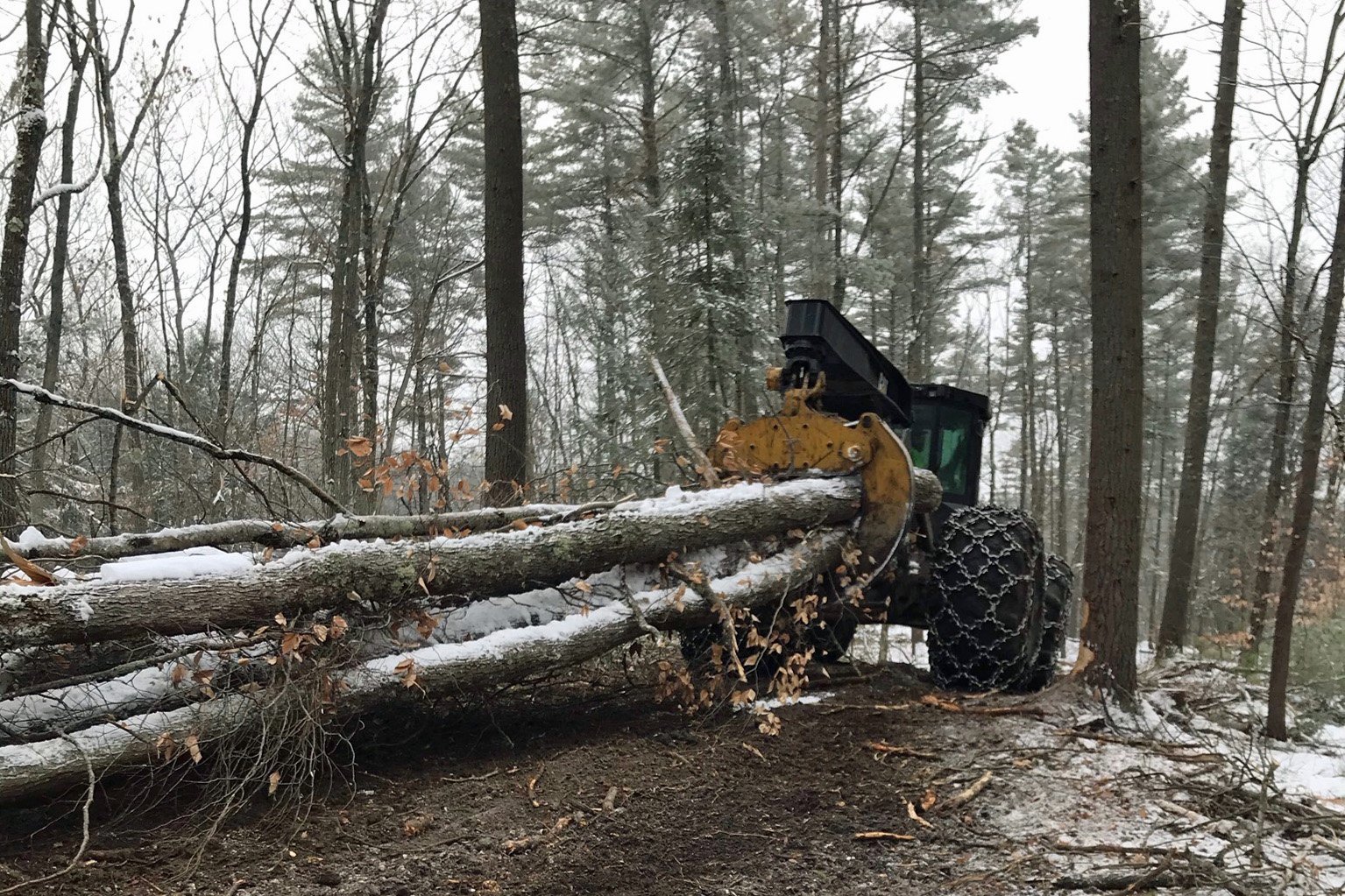
The grapple skidder carefully pulling trees out to the landing at Milarepa Center, Barnet, Vermont, US, December 2020. Photo by Dawn Holtz.
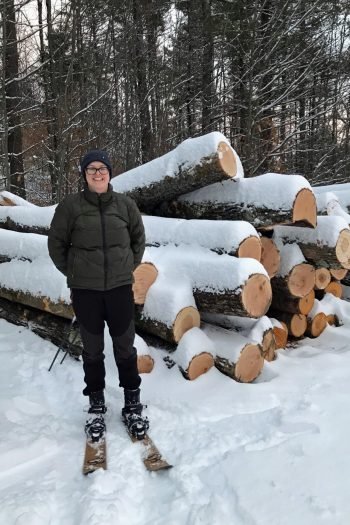
Dawn Holtz with the first cut of timber from the project at Milarepa Center, Barnet, Vermont, US, December 2020. Photo by Jackie Verley.
Milarepa Center, the FPMT center located on 275 forested acres in Barnet, Vermont, US, is working on a project to improve forest health, encourage tree growth, maintain wildlife habitats, and re-establish walking trails with help from foresters Mathias Nevins and Ryan Kilborn, Meadowsend Timberlands, Ltd., and H.B. Logging. Trees cut during the project and sold in a timer sale generated income that will help sustain Milarepa Center during the COVID pandemic. Dawn Holtz, center director, shares the story.
Milarepa Center has successfully completed an almost two-year long forest regeneration project. We are happy to report that all has gone very well and we are quite pleased with the results.
The project began in early 2019, by first creating a very specific, goal-oriented, ten-year forest plan. The forest and trails were then flagged for access and protection of sensitive areas. Equipment was moved in, and active cutting began in December 2020.
The final close-out of the project will take place in May and June 2021. The crew will return to give a final rake to trails. Log landing areas and stream-crossings will be brushed so water can flow through them properly.

Ven. Lhundub Chodron helping with the incense puja at Milarepa Center, Barnet, Vermont, US, December 2020. Photo by Dawn Holtz.
Spiritual preparations were also made for the start of the active cutting phase of the project. A Milarepa Center member who is residing and studying at Nalanda Monastery, an FPMT monastery in France, sponsored a Tara puja. The monks at Nalanda Monastery offered the Tara puja on behalf of Milarepa Center to help clear obstacles during the project.
In addition, Ven. Lhundub Chodron—who has held various positions within FPMT, including serving as director at differnt times of FPMT retreat center Land of Calm Abiding, Lotsawa Rinchen Zangpo Translator Program, and International Mahayana Institute (IMI), as well as serving as a past member of the FPMT, Inc. Board of Directors—happened to be in Vermont the day before the cutting began. Ven. Lhundub Chodron joined in offering an incense puja in order to pacify the many nagas and “landlords” at Milarepa Center.
I worked with a local forester to design the forest plan and lay out the goals for the Milarepa Center forest. They include achieving long-term growth and health of the forest; maintaining fresh water streams flowing throughout the land; protecting existing wildlife habitats and creating new ones; keeping the forest from encroaching on healthy, viable open land; and continuing overall sustainable management of the land and its many resources.
The project focused on an approximately 65-acre parcel of the 275-acre Milarepa Center forest. We implemented a prescribed tree cutting that was laid out in the forest management plan. By cutting down some trees we were able to open the tree canopy and allow sunlight to shine into the forest. This promotes overall forest regeneration within designated areas of the forest. Walking trails were also re-established in the forest as part of the project.
We had hoped to invite students and members out to walk and visit during the project, but due to COVID-19 were unable to. With that in mind, we digitally documented the project. Our forester Ryan Kilborn kindly agreed to help us film what we had hoped to share in person! The video we made will also be used as an educational tool by Meadowsend Timberlands, Ltd., a company that manages private land for landowners. They will use it to show viewers the process and value of good forest management practices adopted by landowners.
Watch the seven-minute video “Milarepa Center Forest Regeneration & Timber Sale Project” on Milarepa Center’s YouTube channel:
https://www.youtube.com/watch?v=JRyjZn_tKgs
To learn more about Milarepa Center, visit their website:
https://www.milarepacenter.org/
FPMT.org and Mandala Publications brings you news of Lama Zopa Rinpoche and of activities, teachings, and events from over 160 FPMT centers, projects, and services around the globe. If you like what you read, consider becoming a Friend of FPMT, which supports our work.
- Tagged: dawn holtz, milarepa center
24
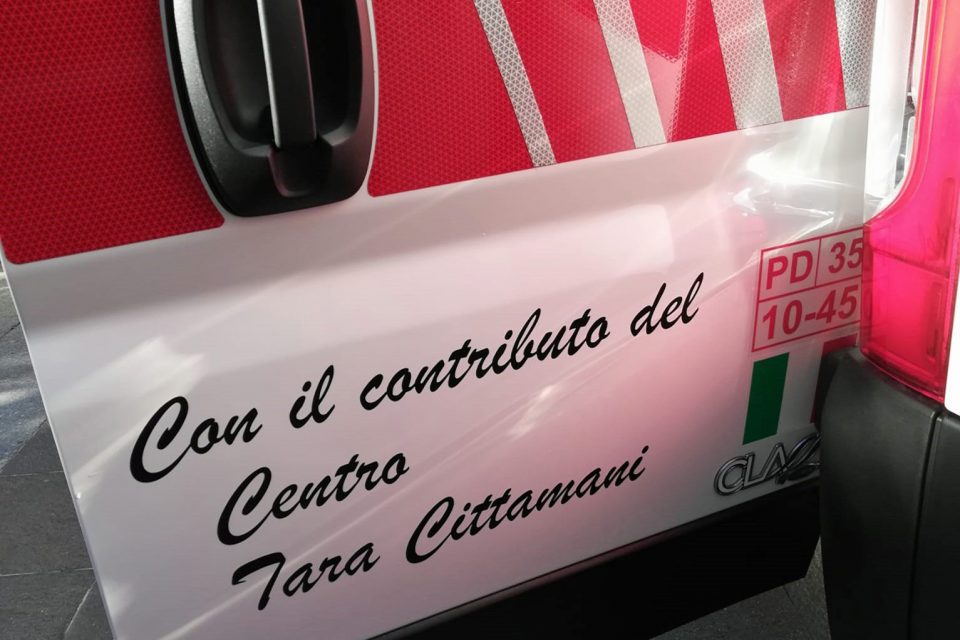
Door of donated ambulance with the message “Con il contributo del Centro Tara Cittamani” (“With the contribution of Tara Cittamani Center”) outside of Palazzo Moroni, Comune di Padova (city hall) during the press conference, Padova, Italy, December 2020. Photo by Marco Parolin.
Centro Tara Cittamani, the FPMT center in Padova, Italy, completed several community service projects in 2020. Community service is one of FPMT’s Five Pillars of Service. Marco Parolin, center director, and Teresa Fabris, spiritual program coordinator, share the story.
Our center, established in 1994, is located in the northeastern part of Italy. Despite the fact that people in this area have a strong connection with the Catholic Church (or maybe because of it), many attend our weekend Dharma teachings and meditation classes. We can count on a membership of 300 to 400 people every year, and with a little help from activities like yoga classes, we manage to keep our financial resources in a good balance.
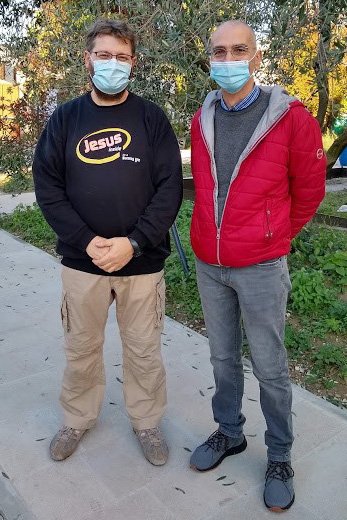
Father Marco Putin and Marco Parolin at the monastery next to Santuario di San Leopoldo Mandic (Saint Leopoldo Mandic Sanctuary), Padova, Italy, October 2020. Photo by Teresa Fabbris.
Things have been a little easier in the past few years, thanks to the fact that by law Italians donate eight percent of their annual income tax return to a church of their choice or the government’s social assistance programs. As of a few years ago people can donate to Buddhists through the Italian Buddhist Union. The association ensures each Buddhist center’s status.
Our center can submit projects to the Italian Buddhist Union. Once approved, our center can receive up to seventy percent of the budget. In 2018, the first year we were able to receive money, we renovated the center. We now have a Dharma library with a rich collection of 800 books in Italian, English, and French on the various Buddhist traditions. We also organized a room with a projector and wide screen so we can watch Dharma events and teachings from other centers.
In 2019, our board of directors decided we had to use the money we receive to give back to our local community. We got in touch with the Padova municipality social services department, who included us in a new project. The municipality has a few apartments for homeless people and people with vulnerabilities. Our task was to go into every apartment and propose cooking classes. In addition to offering seasonal, healthy, vegetarian meal preparation classes, we were also asked to share some useful tools for daily living, including hygiene, tidiness, and a taste for healthy food.
The social services department staff and residents were a little worried about our true intentions—proselytism is always a concern—but the meetings were arranged in the presence of a representative from the social services department.

Donated blast chiller, Santuario di San Leopoldo Mandic (Saint Leopoldo Mandic Sanctuary), Padova, Italy, October 2020. Photo by Teresa Fabbris.
Volunteers brought presents each time they visited the apartments—a few tools to help in the kitchen such as pans or a blender—and enough groceries to prepare the meal twice.
After the second visit, Marco wrote, “This evening we prepared a mushroom soup, chickpea and radish balls, cauliflower humus with olives, and a chocolate cake. Eight people crowded into a tiny kitchen, looking for knives and pans that simply weren’t there. After cooking the meal, we managed to sit down and eat all together. Everyone had something to tell or share. When we left we didn’t know what to say or think. Now back at home I don’t know what to write, but it would be wonderful if every sentient being could have happiness.” We were able to offer five classes before the pandemic made us stop for now.
In 2020, we decided to help a local Catholic monastery of Capuchin monks located next to Santuario di San Leopoldo Mandic. We have been in touch with them for a few years now. They have been preparing meals for homeless people every day since the end of World War II. We help them by collecting food for their kitchen. People who visit our center can leave food items in the shopping cart we keep at the entrance to our center. Every week or so, a volunteer brings the food to the monastery. This project requires minimal effort on our part but is very effective.
In 2020, legislation required the monastery to upgrade their kitchen. We organized a project to help the monks buy some new appliances—an industrial blast chiller, a burner, and three floor washers. The monks haven’t been able to reopen the dining hall due to the COVID pandemic, but they keep distributing shopping bags full of food. We continue to help them collect food.
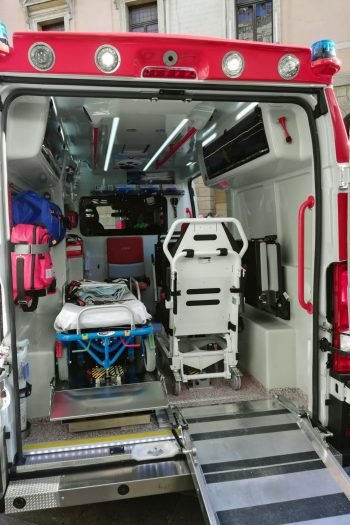
Donated ambulance outside of Palazzo Moroni, Comune di Padova (city hall) during the press conference, Padova, Italy, December 2020. Photo by Marco Parolin.
In March 2020, the Italian Buddhist Union bestowed funds to support every center during this recession. Since we had enough to cover our expenses, we decided we could do something to help our community to cope with the healthcare emergency.
We chose to help the local Red Cross buy an ambulance. With €20,000 (US$23,860) we were able to buy the vehicle. The Red Cross then arranged to use the vehicle to help people with the coronavirus. The ambulance has a sophisticated intensive care system onboard. This allows the Red Cross to transport patients in critical condition over long distances.
These days you can see the ambulance around the streets in Padova, with the message “Con il contributo del Centro Tara Cittamani” (“With the contribution of Tara Cittamani Center”) painted on the side. We hope that the words “Tara Cittamani” will help protect the people who need the ambulance from fear and despair.
Watch the one and a half minute video “Padova, due preziosi regali di Natale per la Croce Rossa” (“Padua, two precious Christmas gifts for the Red Cross”) published by news agency RAI – Radiotelevisione italiana, the national public broadcasting company of Italy, on December 14, 2020:
https://www.rainews.it/tgr/veneto/video/2020/12/ven-Emergenza-sanitaria-Padova-Ambulanze-nuove-donate-alla-Croce-Rossa-6099f05e-3aa4-46f8-a074-cdb0176c116e.html
We used the remaining €10,000 (US$11,928) to help the local city hospital buy diagnostic kits and screening tests for healthcare workers.
We also use the shopping cart at the entrance to our center to collect food and blankets for animals in need. We periodically bring these donations to local nonprofit animal shelters. We are also preparing to help an animal shelter near Padova with needed renovations. The animal shelter wants to improve their shelters for dogs and cats to better protect them from the cold and extreme heat.
To learn more about Centro Tara Cittamani, visit their website:
http://www.taracittamani.it/
FPMT.org and Mandala Publications brings you news of Lama Zopa Rinpoche and of activities, teachings, and events from over 160 FPMT centers, projects, and services around the globe. If you like what you read, consider becoming a Friend of FPMT, which supports our work.
17
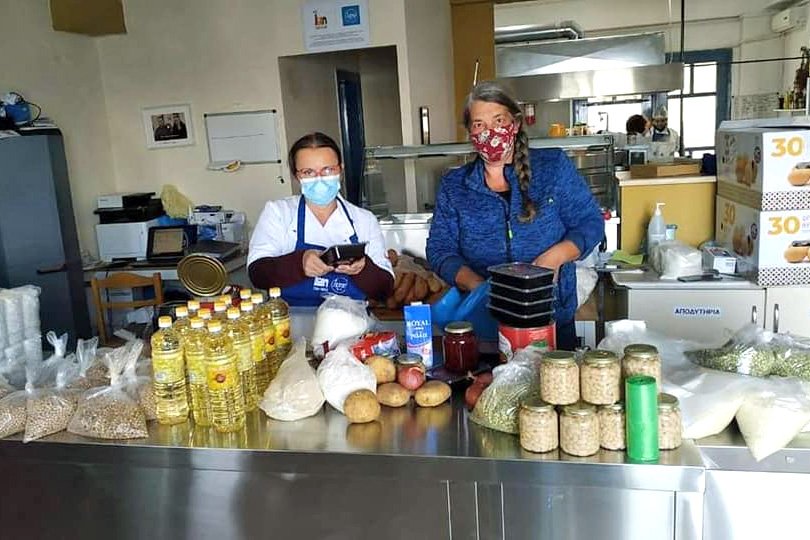
Doro Blancke and a friend, supporters of Team Gabitz Helps, preparing food for distribution to the community in Kara Tepe camp, Lesbos, Greece. December 2020. Photo courtesy of Doro Blancke.
Panchen Losang Chogyen Gelugzentrum, the FPMT center in Vienna, Austria, has raised awareness and support for the thousands of people living in Kara Tepe camp by collecting financial contributions for Gablitz hilft (Gablitz helps.) Kara Tepe is a camp for refugees and asylum seekers—the majority from Syria, Iraq, and Afghanistan— on Lebos, a Greek island in the northern Aegean Sea off the coast of Turkey. Moria, another camp on the island, experienced a devastating fire in September 2020. Gablitz hilft is an all-volunteer organization in Gablitz, Niederösterreich, Austria, that has been accompanying persecuted and refugee people through everyday life since 2015. Community service is one of FPMT’s Five Pillars of Service. Maragarete (Margit) Sinabell, spiritual program coordinator at Panchen Losang Chogyen Gelugzentrum, shares the story.
On October 20, 2020, I saw a media report with the headline “Refugees on Lesbos: ‘Even in Moria it was better.'” This report touched me very much. Due to the COVID situation, knowledge of the refugees’ suffering has moved into the background. It is very important to me to stand up for them. Refugees on Lesbos are starving and freezing. They lack winterproof tents, sources of heat, and access to sanitary facilities for daily toilet needs. Without these things, it is hard to keep children safe and warm.
Gablitz hilft has been involved in refugee aid for years. Two Gablitz hilf volunteers, Doro and Helga work with the nonprofit organization Home for All. Founded by Greek locals Nikos and Katherina, Home for All is a social charity kitchen supporting the refugee community. They provide food to 1,200 people every day. On December 4, 2020, Helga journaled, “It keeps raining! From dawn to dusk we are busy supporting Nikos and Katherina with shopping, packing, and delivering the Home-for-All-meals.” They also purchase clothing, firewood, and other necessities such as children’s shoes, sanitary products, and latrines. There are additional 6,800 people in the refugee camp who lack even the most basic necessities.
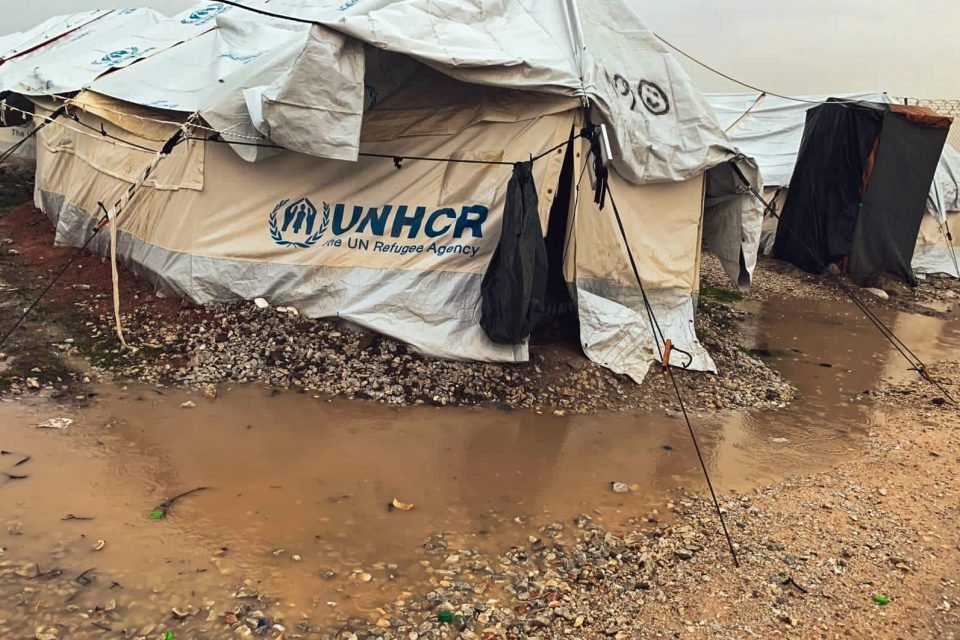
Kara Tepe camp, Lesbos, Greece, December 2020. Photo courtesy of Doro Blancke.
I personally know a member of the Gablitz hilf board of directors. Karin is a doctor who drives to Greece as often as she can to provide medical care to the refugees. She is a Christian, but as a Buddhist I see her as a great bodhisattva. I’ve worked with Karin several times on different projects. I have been helping and supporting Gablitz hilf for years. However, we can achieve even more if we all join together.
I created a proposal for our center’s board of directors to review at their November 4 meeting, encouraging our center to get involved and financially support Gablitz hilf’s work. Our board of directors decided to appeal to our members and interested parties for donations. (No one from our center is traveling to Lesbos to help.) As a Dharma center, it’s important for us to help others as best as we can. Financial donations are the best way we can help right now. The transport of goods across borders has become difficult due to COVID.
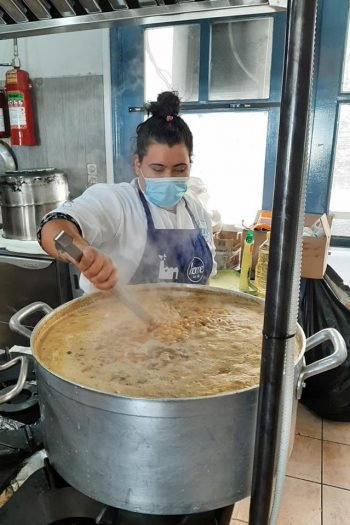
A person cooking a hot meal for the community in Kara Tepe camp, Lesbos, Greece, December 2020. Photo courtesy of Doro Blancke.
Our fundraising campaign led to a pleasant snowball effect and was even picked up and spread by partners in Belgium. The result far exceeded our expectations and touched our hearts deeply. By January 25, we had collected a total of € 8,729 (US$10,514.) Since Gablitz hilf is an all-volunteer organization, all of the donations we sent went to the refugees in Kara Tepe camp on Lesbos for food, care, hygiene items, and a permanent living space. The refugees and everyone involved are very happy.
Alice Grundboeck, the previous center director, shared some thoughts about community service. Alice said, “It allows students to practice Dharma in daily life, and it empowers students. Non-Buddhists can get an impression of what Buddhism means. When we do community service we meet people of different faiths. This can blossom into further cooperation regarding community service. We just began another project, supporting Tierparadies Schabenreith (Schabenreith animal paradise), a sanctuary in Austria that prevents animals from being killed too.”
For more information about Panchen Losang Chogyen Gelugzentrum, visit their website:
https://gelugwien.at/
For more information about Kara Tepe camp, visit the International Refugee Committee (IRC) website. IRC is one of the organizations running services in the camp:
https://www.rescue.org/country/greece
FPMT.org and Mandala Publications brings you news of Lama Zopa Rinpoche and of activities, teachings, and events from over 160 FPMT centers, projects, and services around the globe. If you like what you read, consider becoming a Friend of FPMT, which supports our work.
- Tagged: community service, community-social service pillar, panchen losang chogyen, panchen losang chogyen gelugzentrum
8
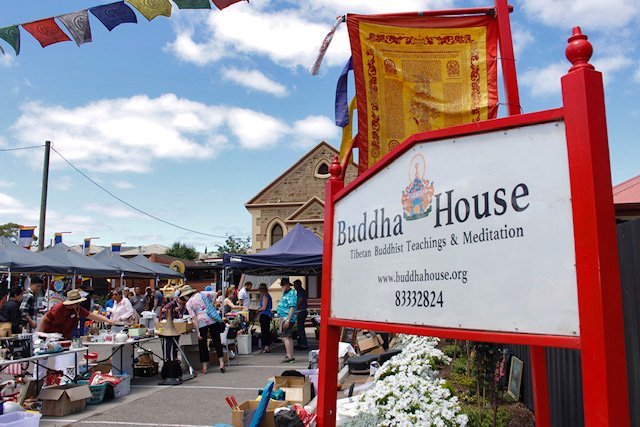
Buddha House fete and open day, Magill, South Australia, Australia, January 2021. Photo by Kaya Migalka.
Buddha House, the FPMT center in Magill, South Australia, Australia, held their first free-entry fete and open day on Saturday, January 30, 2021, from 10 a.m. to 3 p.m. at the center. Hundreds of visitors browsed the outdoor stalls, visited the gift shop, saw the holy objects in the gompa, experienced a meditation or short talk by Gen Thubten Dondrub, and enjoyed Malaysian street food in the student lounge. Funds raised will help the Adelaide-area center keep up with ongoing expenses and maintenance needs. Income generation is one of FPMT’s Five Pillars of Service. Carole Migalka, fete coordinator, shares the story.
Inspired by the stories in Big Love: The Life and Teachings of Lama Yeshe of festivals held at Manjushri Institute and Sandhurst Town and Lama Yeshe’s encouragement to bring people together in an informal setting, our center decided to revive the pioneer student’s spirit with a community fete and open day.
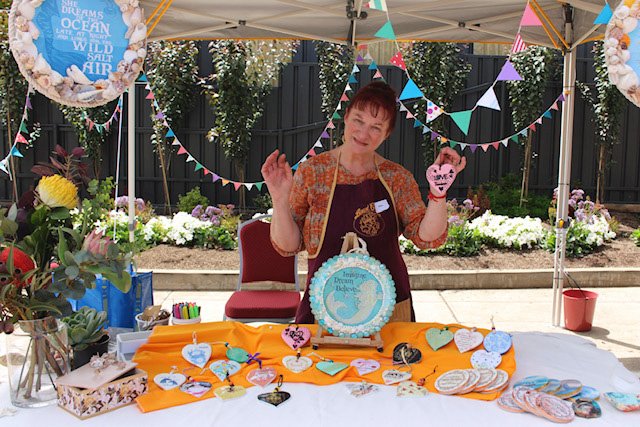
Buddha House office volunteer Shez Malone running a craft stall at the Buddha House fete and open day, Magill, South Australia, Australia, January 2021. Photo by Kaya Migalka.
The idea was simple: welcome neighbors, friends, and community members with food, drinks, and market stalls; show them around the center; and let them sample the Buddha House program. “Come and try meditation” sessions were offered, as well as a short Dharma talk, “What does it mean to be a Buddhist?” with FPMT resident teacher Gen Thubten Dondrub*—himself one of the early Western sangha.
When the Facebook event was shared and tagged widely, the committee knew we had generated some interest, but we could not have anticipated the wonderful support received. Well over 500 people visited on a perfect mild, summer day.
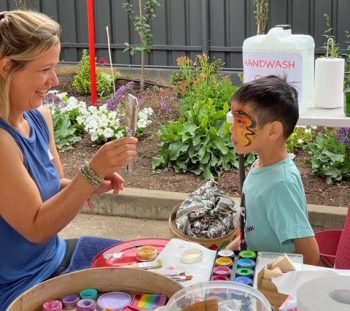
Buddha House Dharma Kids Club (DKC) coordinator Sascha Holyoak with DKC member David at a face painting stall at the Buddha House fete and open day, Magill, South Australia, Australia, January 2021. Photo by Kaya Migalka.
Delicious homemade food was offered by the Malaysian community; volunteers baked cakes, potted plants, and donated goods; and then all pitched in on the day of the fete to work on the stalls. The atmosphere was one of joyous effort offered by over thirty volunteers.
The community responded with joy, sharing with us, “I had always wanted to visit, but wasn’t sure when to come;” “I had driven past many times but didn’t know what it was;” and “We had no idea there was such a diverse program.”
The primary motivation for the day was to bring people to the Dharma, but it also resulted in a successful fundraiser with much-appreciated income going toward maintenance of the beautiful heritage chapel that is home to the Buddha House gompa.
With such a wonderful time had by all, this could become an annual tradition. Who knows we might even bring back Lama Yeshe’s favorite, the gumboot throwing event.
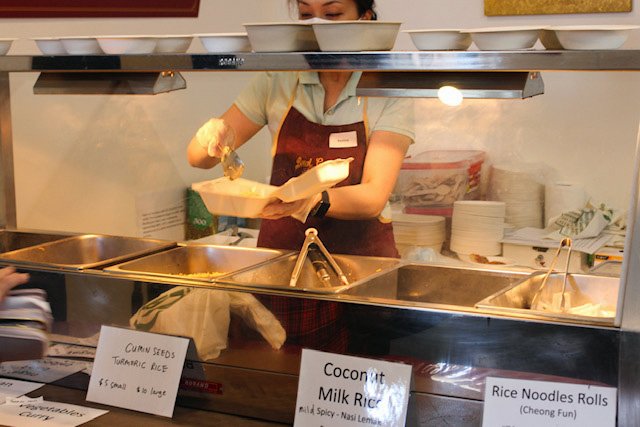
Malaysian food stall volunteer Eunice serving food donated by the Malaysian community at the Buddha House fete and open day, Magill, South Australia, Australia, January 2021. Photo by Kaya Migalka.
* In 2019 Gen Thubten Dondrub requested Buddha House students formally refer to him as “Gen Thubten Dondrub.” He shared, “Usually monks and nuns of the FPMT are referred to as ‘Venerable.’ I have always found this term uncomfortable as it is a very exalted term and is used in the Catholic Church to refer to someone who is in line to be canonized as a saint. When I was in Taiwan I learned that every monk and nun was addressed as ‘Fa Shr’ from the moment they were ordained. The term means ‘Dharma teacher.’ The closest Tibetan equivalent is ‘ge.gen,’ often abbreviated to ‘Gen’ or ‘Gen-la.’ It is polite and friendly. So when people ask how to address me, I suggest using that term. It seems much more appropriate than ‘Venerable.'”
For more information about Buddha House, visit their website:
http://buddhahouse.org
FPMT.org and Mandala Publications brings you news of Lama Zopa Rinpoche and of activities, teachings, and events from over 160 FPMT centers, projects, and services around the globe. If you like what you read, consider becoming a Friend of FPMT, which supports our work.
- Tagged: big love, buddha house, carole migalka, five pillars, income generation, lama yeshe, ven. thubten dondrub
4

Chaplain Roy Poulter and Seamus Lennon from Leeds Street Outreach with donations from the Jamyang Leeds community, Leeds, UK, December 2020. Photo courtesy of Chaplain Roy Poulter.
In 2020, Jamyang Buddhist Center Leeds, the FPMT center in Leeds, UK, offered support to the UK National Health Service, the UK’s publicly funded healthcare system; the homeless population in Leeds; and individuals needing chaplaincy care as part of the center’s Buddhist chaplaincy service. Community service is one of FPMT’s Five Pillars of Service. Trustee Chrissie Martindale, Buddhist Chaplain Roy Poulter, and center director Kerry Prest share the story.
We are fortunate to have some wonderfully passionate individuals at Jamyang Leeds who work for others by offering their time and energy in a number of outreach projects. Here are two from the lockdown months of 2020.
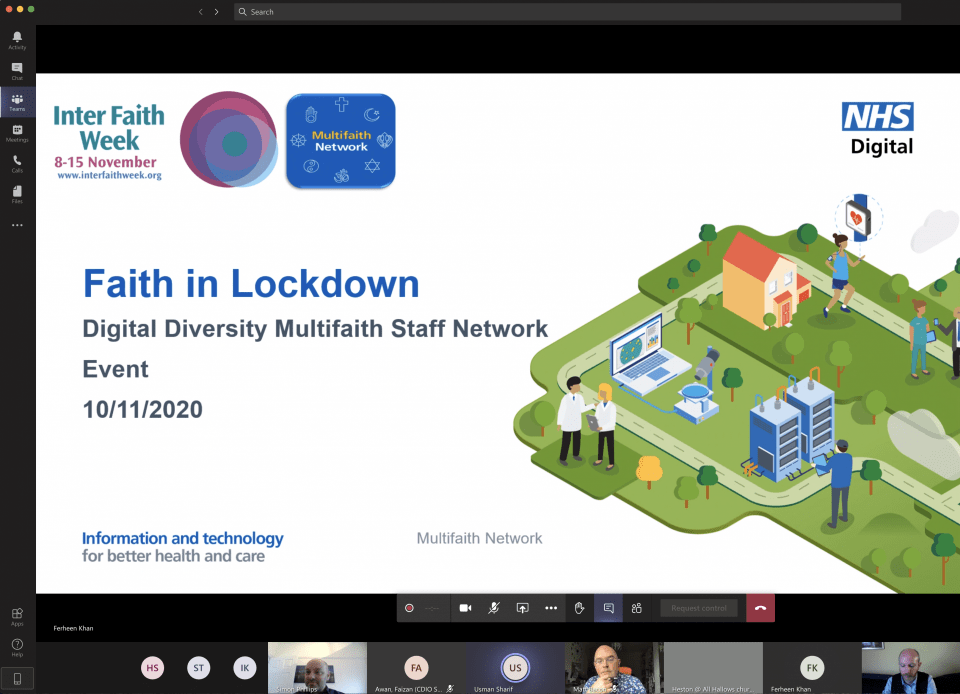
Faith in Lockdown: Digital Diversity Multifaith Staff Network Event, Microsoft Teams online meeting, November 2020. Photo by Kerry Prest.
Supporting Our UK National Health Service
During 2020, we offered three sessions on meditation and Buddhism to the UK National Health Service (NHS.) One such session was in December. Usman Sharif, chair of the NHS Multifaith Network, asked if we would be interested in doing a short introduction to Buddhist meditation for the Women’s Network at NHS Digital, which of course we were delighted to do. The Women’s Network holds weekly sessions on wellbeing for staff on Zoom. These sessions provide a safe and supportive environment to explore wellbeing and to take a break from the day to day pressures of working for the NHS, especially during the COVID-19 pandemic.
They were interested in exploring meditation from different faith perspectives. Chrissie Martindale kindly volunteered to help. After a brief chat to find out what they would like, Chrissie joined one of the sessions to chat about why meditation is important from a Buddhist perspective. Chrissie explained the difference between shamatha and analytical meditations followed by a practical session meditating on loving kindness.
Some of the group had experienced meditation before and others not. Some had previously thought meditation wasn’t for them as their minds were just “too busy.” There were lots of positive comments afterwards on how they had enjoyed the experience and felt more relaxed. We have offered to go back whenever they would like us to do so.
Chrissie says, “It was really lovely to connect with our local NHS workers at a time when they’re working so hard to keep us all safe and well. We have some fabulous tools to share. Even just fifteen minutes of loving kindness meditation was so relaxing for the group and so much needed at this time.”
Chaplaincy
The COVID-19 pandemic has caused chaos around the world and not least for chaplains attending to the needs of patients, prisoners, and those in need. During the last ten months voluntary chaplains have been asked not to attend hospitals for their own safety unless it is an end-of-life visit.
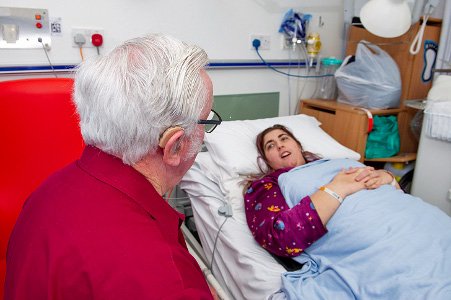
Chaplain Roy Poulter attending the sick, Leeds, UK, October 2019. Photo courtesy of Chaplain Roy Poulter.
Our lead chaplain Roy Poulter reports, “Trying to keep myself busy, I talk to people over the telephone and on Zoom to keep their spirits up.
“We also have a wonderful community who donate warm clothing, underwear, shoes, and toiletries when we put a call out. We liaise with three homeless charities in Leeds who distribute the clothing directly to the homeless on the street. Over the last three years we have dealt with homeless people in hospitals, many of which are drug users, and I have found them really nice to work with.
Back in September 2020, I received a call from the lead chaplain, a Christian, at Lincoln General Hospital. I was asked to attend a gentleman who was a Tibetan Buddhist and was dying. I drove the 250-mile round trip to attend him, and he passed away while I was there. We have also been asked to help with a couple of other funerals and of course did so. I can’t wait to get back to normal, visit our hospitals, and see people face to face.”
For more information about Jamyang Buddhist Centre Leeds and the center’s Buddhist chaplaincy outreach work, visit their website:
https://jamyangleeds.co.uk/
FPMT.org and Mandala Publications brings you news of Lama Zopa Rinpoche and of activities, teachings, and events from over 160 FPMT centers, projects, and services around the globe. If you like what you read, consider becoming a Friend of FPMT, which supports our work.
- Tagged: chaplaincy, chrissie martindale, community service, community-social service pillar, covid-19, jamyang buddhist centre leeds, kerry prest, roy poulter
1
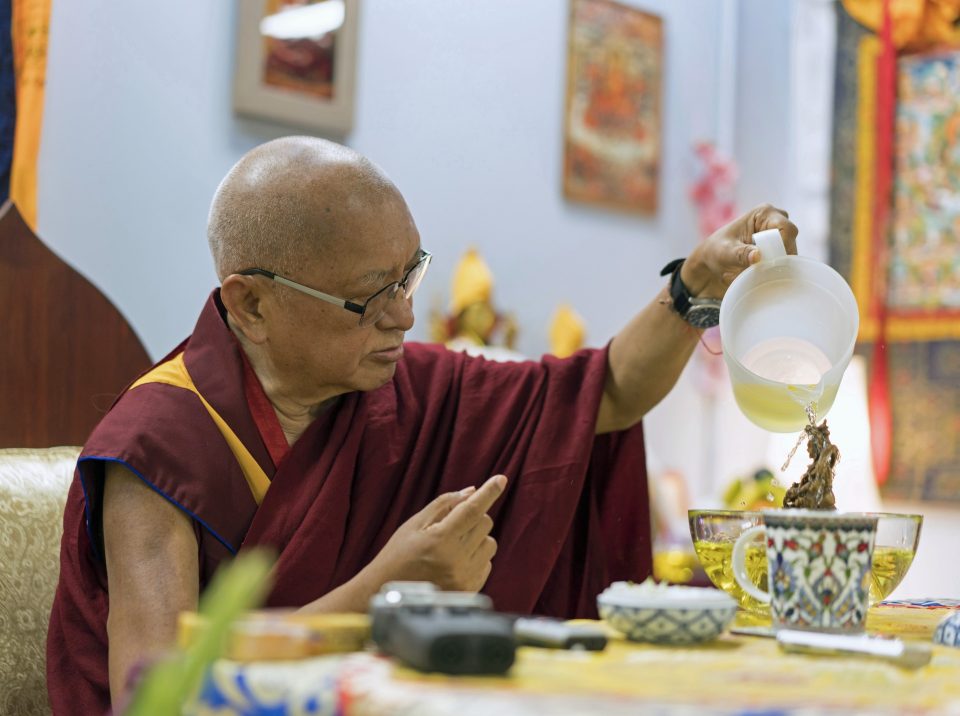
Lama Zopa Rinpoche at Nagarjuna’s Wisdom Center, Bilbao, Spain, May 2019. Photo by Ven. Lobsang Sherab.
FPMT center Centro La Sabiduría de Nagarjuna (Nagarjuna’s Wisdom Center) in Bilbao, Spain, began as an FPMT study group in December 2012 with four members. They affiliated and became an FPMT center in April 2016. Koke Muro, center director, shares the story about the center’s newest big project—Lama Tsongkhapa Retreat Place.
Everything started in 2008, when I had an interview with Khensur Rinpoche Lama Lhundrup at Kopan Monastery, the FPMT monastery in Kathmandu, Nepal. I had just met the Dharma a few months earlier in Bodhgaya, Bihar State, India, and asked Khensur Rinpoche Lama Lhundrup what to do to learn more. Khensur Rinpoche Lama Lhundrup told me to do retreat in my city center once a year. I replied that there wasn’t a center in my city, and Khensur Rinpoche Lama Lhundrup told me, “You can open one.”
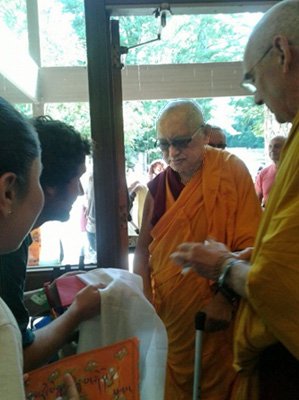
Bea Rentería and Koke Muro offering Rinpoche a letter, asking if there was the karma for a retreat center, Light of the Path Retreat, Black Mountain, North Carolina, US, August 2016. Photo courtesy of Nagarjuna Wisdom Center.
Many things have happened since then.
In 2012, I started Nagarjuna’s Wisdom Study Group, and with the support of a nice group of people and Ven. Nerea Basurto, the study group became Nagarjuna’s Wisdom Center. In 2016, a small group of people from Bilbao, Spain, saw the need for a retreat place closer to Bilbao, which is on Spain’s north coast. We wrote a letter to Kyabje Lama Zopa Rinpoche, asking if there was karma for a project like that in Spain’s Basque Country, and delivered the letter to Rinpoche at the Light of the Path retreat.
Rinpoche replied, “If the study group does the extensive Medicine Buddha puja composed by the Fifth Dalai Lama every month or every week then the project comes out very good. Otherwise, it is of little benefit.” We have been doing the Medicine Buddha Puja every week and the extensive Medicine Buddha puja every month since then.
Inspired by the FPMT center Land of Joy in Northumberland, UK, we decided to invite as many people as possible to help collect merit for the project. In October 2018, our center offered Rinpoche one million completed recitations of the Medicine Buddha mantra.
In April 2019, we were extremely lucky to receive a name for their project from Rinpoche—”Lama Tsongkhapa Retreat Place.” In May 2019, Rinpoche stopped in Bilbao for the afternoon on his way to the FPMT center Institut Vajra Yogini in Lavaur, France. Rinpoche very kindly gave a teaching to Nagarjuna’s Wisdom Center board members and management committee on Yellow Dzambhala. He recommended our center do the Yellow Dzambhala practice for any project we may have in mind.

Dzambhala statues at Nagarjuna’s Wisdom Center, Bilbao, Spain, September 2019. Photo by Paloma Fernandez.
In June 2019, one million completed recitations of the long Vajrasattva mantra were offered to Rinpoche on behalf of the retreat center project. That same year a suitable place appeared. Rinpoche said it would be best if we could invite Tan Hup Cheng, center director of Amitabha Buddhist Centre, the FPMT center in Singapore, to assess the feng shui of the land. Tan Hup Cheng came in August 2019 and gave advice on the feng shui of the property.
After completing the Vajrasattva mantra accumulation we decided to start the Yellow Dzambhala practice with the water offering practice. Sixty Yellow Dzambhala statues were sent from Kopan Monastery. Geshe Tenzin Zopa, FPMT touring geshe, happened to be in Bilbao when the statues arrived and consecrated them. The statues were then offered to anyone who committed to doing a minimum of one mala a week of the Yellow Dzambhala mantra.
One year later, in October 2020, one million completed recitations of the Yellow Dzambhala mantra were offered to Rinpoche. He showed the aspect of being very pleased, sending our team a nice message and this lovely smile.

Drawing by Lama Zopa Rinpoche, October 2020.
Now we are collecting 10 million recitations of a success mantra, also advised by Rinpoche, which is called Holy Name Mantra That Fulfills Wishes and is found in The Method to Transform a Suffering Life into Happiness (Including Enlightenment) with Additional Practices. (Rinpoche advised we recite the mantra and then we set the goal of 10 million mantras.)
DE ZHIN SHEG PA SA DZIN GYÄL PO LA CHHAG TSHÄL LO
To Tathagata Earth-Holder King, I prostrate.
TAYATHĀ / OṂ DHARE DHARE / DHARAṆI BÄNDHE SWĀHĀ
We feel unbelievably fortunate to have so many people supporting this project under the amazing guidance of Lama Zopa Rinpoche. We will continue working to create a Western Kopan in the north of Spain for everyone to enjoy the Dharma, engage in retreat, study, and achieve lamrim realizations.
To learn more about Centro La Sabiduría de Nagarjuna (Nagarjuna’s Wisdom Center), visit their website:
https://nagarjunabilbao.com/
To contribute to the goal of 10 million recitations of the success mantra, contact:
retiros.lamatsongkhapa@gmail.com
FPMT.org and Mandala Publications brings you news of Lama Zopa Rinpoche and of activities, teachings and events from over 160 FPMT centers, projects and services around the globe. If you like what you read, consider becoming a Friend of FPMT, which supports our work.
- Tagged: Centro La Sabiduría de Nagarjuna, khensur rinpoche lama lhundrup, koke muro, lama tsongkhapa retreat place
22
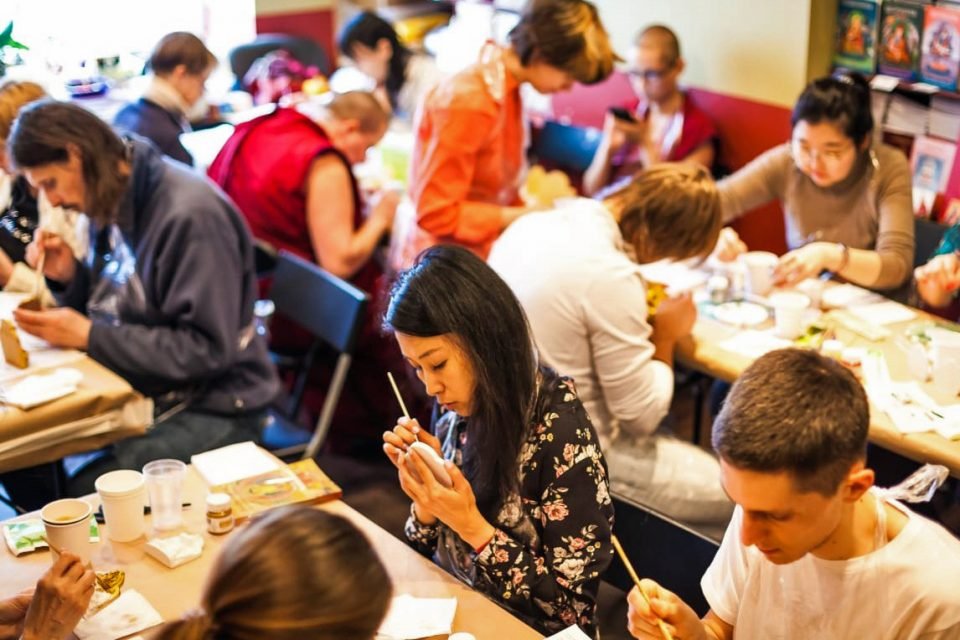
Painting tsa-tas during Losar, Ganden Tendar Ling Center, Moscow, Russia, March 2020. Photo by Artur Balbakov.
Ganden Tendar Ling Center, the FPMT center in Moscow, Russia, has been teaching the tsa-tsa making practice since November 2019 and has introduced the tsa-tsa making practice to the two FPMT study centers in Russia, Aryadeva Study Group and Lama Tsongkhapa Study Group. Tatiana Ilina, Ganden Tendar Ling Center volunteer and tsa-tsa workshop coordinator, shares the story.
The story of the tsa-tsa workshop in Moscow began in September 2019, when Lama Zopa Rinpoche attended an animal blessing event in the city at the request of the Save Tibet Foundation in Moscow. Ganden Tendar Ling Center volunteers were asked to organize an altar, and to do this they had to make as many tsa-tsas as possible.

Tsa-tsas painted by Liubov Kriakina at Aryadeva Study Group, St. Petersburg, Russia, November 2020. Photo by Liubov Kriakina.
I had learned the tsa-tsa making practice at the Root Institute for Wisdom Culture, the FPMT center in Bodhgaya, Bihar, India, from Ven. Tenzin Dekyong. I took up the task of organizing the making of the tsa-tsas for the animal blessing event.
We used funds we had raised to purchase several tsa-tsa molds from Nalanda Monastery, the FPMT monastery in the South of France. A small group of volunteers from Moscow and Yekaterinburg managed to make about four hundred tsa-tsas in a short amount of time.

Tatiana Ilina and Nima Panyukova leading a tsa-tsa making workshop at Ganden Tendar Ling Center, Moscow, Russia, November 2019. Photo courtesy of Ganden Tendar Ling Center.
It turned out that a lot of people wanted to learn the tsa-tsas making practice. As we already had the molds, in November 2019, another volunteer, Nima Panyukova and I began to conduct a monthly training on the tsa-tsa making practice for anyone who wanted to learn. Despite the pandemic, about twenty group practices were conducted—attended by more than eighty people—and more than 1,000 tsa-tsas were made. All of the completed tsa-tsas are transferred to the Moscow Stupa of Enlightenment for distribution to stupa visitors.
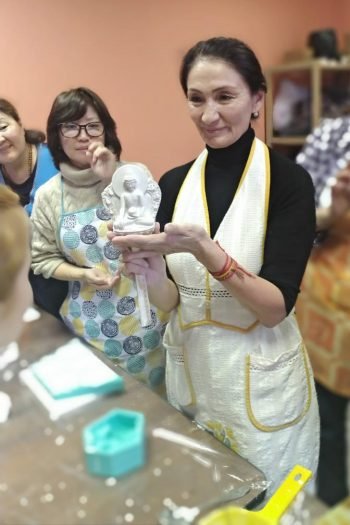
Nima Panyukova, a tsa-tsa workshop coordinator at Ganden Tendar Ling Center, Moscow, Russia, January 2020. Photo by Tatiana Ilina.
In August 2020, we went to St. Petersburg, and held a training on the tsa-tsa making practice at Aryadeva Study Group. Local volunteer Liubov Kriakina, a professional art restorer was very inspired by the tsa-tsa making practice. Liubov now leads a tsa-tsa making practice in St. Petersburg and teaches people how to paint the tsa-tsas.
Moscow volunteers donated two silicone tsa-tsa molds to the Lama Tsongkhapa Study Group in Yekaterinburg. Ven. Tenzin Yangi and study group coordinator Sergey Kuvaev now lead a tsa-tsa making practice in Yekaterinburg.
In December 2020, we presented a tsa-tsa to Telo Tulku Rinpoche, honorary representative of His Holiness the Dalai Lama in Russia, Mongolia, and the Commonwealth of Independent States (CIS) countries.
Telo Tulku Rinpoche highly praised the quality of the tsa-tsa. He expressed his wish that we teach the practice of making tsa-tsas from plaster to as many people as possible and in various Russian cities. This will contribute to the revival of Buddhist art in Russia.
We are planning a trip to Kalmykia to share our experience making tsa-tsas from plaster in accordance with Telo Tulku Rinpoche’s wish.

Luibov Kriakina leading a one-day Green Tara tsa-tsa painting practice at Aryadeva Study Group, St. Petersburg, Russia, January 2021. Photo by Budyma Tsoktoeva.
To learn more about Ganden Tendar Ling Center, visit their website:
https://fpmt.ru/
FPMT.org and Mandala Publications brings you news of Lama Zopa Rinpoche and of activities, teachings, and events from over 160 FPMT centers, projects, and services around the globe. If you like what you read, consider becoming a Friend of FPMT, which supports our work.
- Tagged: ganden tendar ling, russia, tatiana ilina, telo rinpoche, tsa-tsas
16
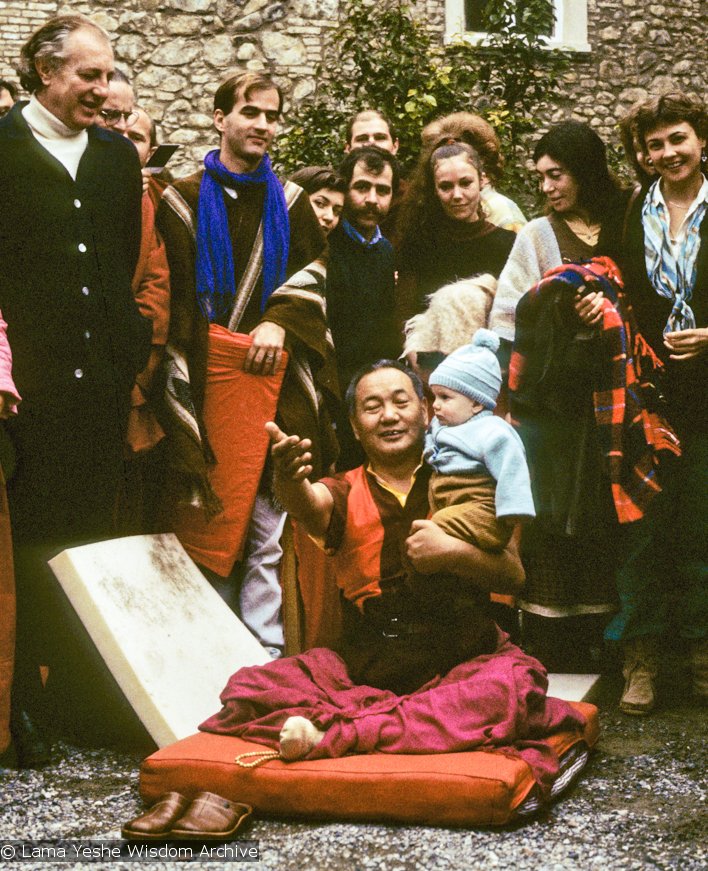
Lama Yeshe with children and families at Istituto Lama Tsongkhapa, Italy, 1983. Photos by Ueli Minder, courtesy of Lama Yeshe Wisdom Archive.
For FPMT students, Losar, the Days of Miracles, and Chotrul Duchen have an important significance as it commemorates the anniversary of the parinirvana of Lama Thubten Yeshe, who co-founded FPMT with Lama Zopa Rinpoche. As part of Lama Zopa Rinpoche’s advice on how to best use this sacred time of year, in addition to doing pujas and recitations, Rinpoche recommends taking time to share stories and remembrances of Lama Yeshe.
During the 100 Million Mani retreat at Istituto Lama Tzong Khapa in Italy in 2017, there were two sessions during which long-time FPMT students shared their stories of Lama Yeshe. These touching memories included stories from the early days at Kopan Monastery on the outskirts of Kathmandu, Nepal, and Lawudo Gompa, high up in the Himalayas, as well as from the time Lama Yeshe spent in Italy, France, and Spain. Lama Zopa Rinpoche and Tenzin Osel Hita, the reincarnation of Lama Yeshe, also make appearances in these stories.
We are happy to share two videos of these informal sessions. Please enjoy these touching accounts of Lama Yeshe’s kindness and wisdom as told by Massimo Corona, Ven. Elisabeth Drukier, Ven. Charles, Paula de Wys, Piero Cerri, and Ven. Zia Bassam.
Watch stories about Lama Yeshe from senior FPMT students (Massimo Corona, Ven. Elisabeth Drukier, and Ven. Charles):
https://youtu.be/al0YNTbWkUc
Watch stories about Lama Yeshe from senior FPMT students (Paula de Wys, Piero Cerri, and Ven. Zia Bassam):
https://youtu.be/PPddKA1zAFQ
These videos are also available in Spanish:
https://youtu.be/Q3xJ9DXjrlQ
https://youtu.be/YaV8WNsskb0
You can also watch them in Italian:
https://youtu.be/OYzrrfO4lPE
https://youtu.be/MXahdgQ8q6I
Read more about Losar, the Fifteen Days of Miracles, and what practices to do during this auspicious period.
For more stories about Lama Yeshe and hundreds of photos of Lama Yeshe with early students, see Big Love: The Life and Teachings of Lama Yeshe, published by the Lama Yeshe Wisdom Archive.
Through timely advice, news stories, and updates, FPMT.org and Mandala Publications share the wisdom culture inspired and guided by the teachings of FPMT founders Lama Thubten Yeshe and Lama Thubten Zopa Rinpoche.
- Tagged: fpmt history, lama yeshe, massimo corona, paula de wijs, piero cerri, tenzin osel hita, ven. charles, ven. elisabeth drukier, zia bassam
5
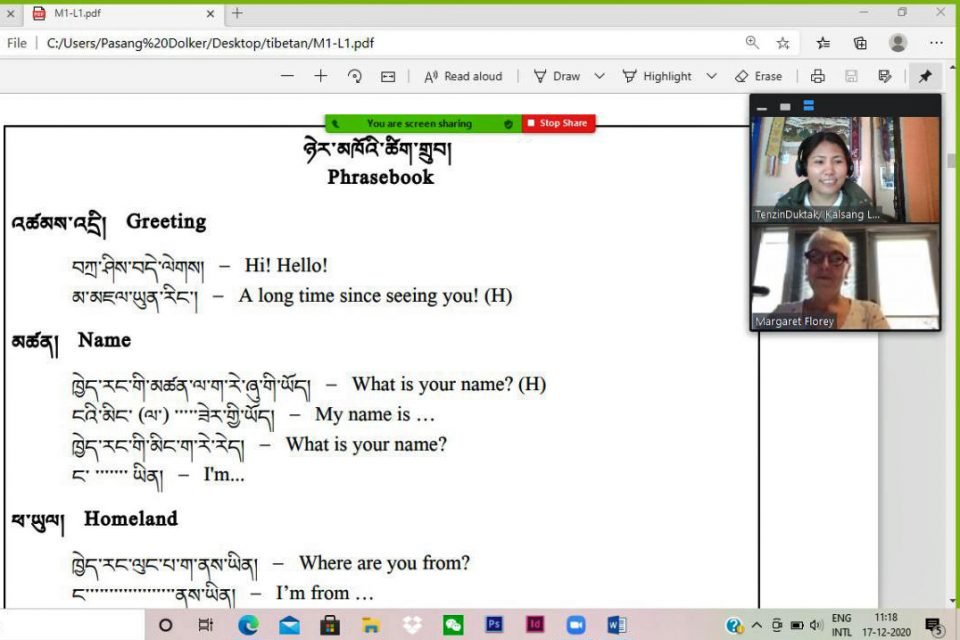
Pasang Dolkar screen sharing materials with her student as she teaches, December 2020. Photo courtesy of LRZTP.
Lotsawa Rinchen Zangpo Translator Program (LRZTP), an FPMT project in Dharamsala, Himachal Pradesh, India, has been adapting to the COVID pandemic after having to postpone the commencement of their next two-year Tibetan language and interpreters training course, LRZTP 9. Julia Wilson, coordinator, shares the story.
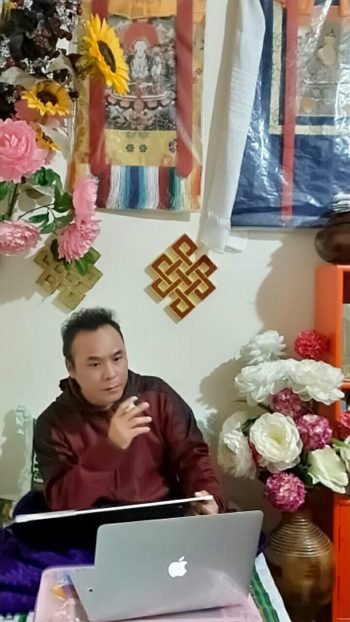
LRZTP senior teacher Thupten la conducting class online from home, December 2020. Photo courtesy of LRZTP.
The LRZTP is well-known for its rigorous two-year Tibetan language and interpreters training course, which has produced many gifted Dharma interpreters-translators for FPMT Dharma centers since its conception over twenty years ago. In addition to the two-year intensive training program, LRZTP also runs short Tibetan language courses and offers private online Tibetan language lessons. Now, in March 2021, LRZTP is launching a fully online Tibetan language study program: Foundations in Tibetan Language.
LRZTP is helping the FPMT by continuing to offer intensive language and interpretation/translator training for future FPMT center interpreters. The other Tibetan language learning opportunities at LRZTP help the FPMT and the Dharma in that studying in one of the other programs is often a bridge to making a greater commitment to learning the language and the Dharma. Students without the goal of becoming Dharma interpreters often study the language with goals that range from being able to recite their prayers in Tibetan, being able to communicate directly with their center’s resident geshe and so forth, to being able to study Dharma texts and receive teachings directly in Tibetan.
Our last two-year course, LRZTP 8, luckily was finished just as India went into lockdown in March 2020, and all students luckily were able to graduate without issue. The next course, LRZTP 9, was originally scheduled to commence in October 2020, but had to be postponed due to the continuing pandemic situation. If the world becomes safe again for international travel, etc., then it may be feasible that the next long course could commence as early as autumn 2021—fingers crossed!
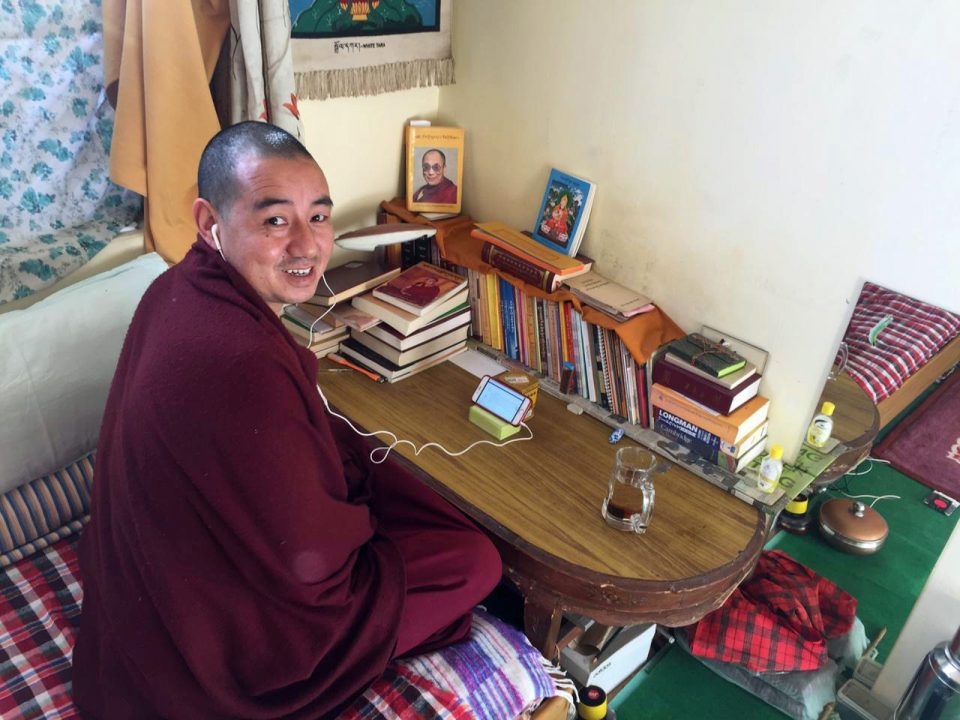
Ven. Samdup Lungtok is also teaching Tibetan online from home, December 2020. Photo courtesy of LRZTP.
On the bright side of things, the pandemic situation has given us an opportunity to focus on further developing our online Tibetan language individual tutoring service as well as launch a fully online Tibetan language study program.
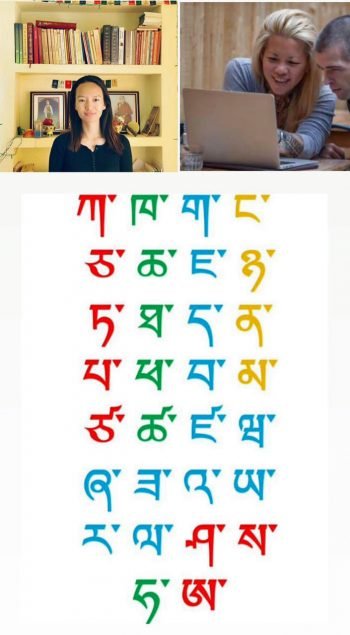
LRZTP Tibetan language tutor Dhamchoe Kyi with online students, December 2020. Photo courtesy of LRZTP.
To help facilitate the transition to teaching online for LRZTP language tutors who had been part of the onsite program, from September through December the program’s main teacher, Geshe Tenzin Wangdak, conducted several online training workshops for them with a focus on methods to teach Tibetan as a foreign language online. He also included some training for those tutors who have Dharma backgrounds in methods for teaching the Dharma in Tibetan to non-native speakers. Presently, we have about thirteen native speaker Tibetan language tutors available online for one-on-one tutoring.
Foundations in Tibetan Language, LRZTP’s new online study program, commences following the Tibetan new year in March 2021. The comprehensive program—introductory level through to advanced levels, including Dharma terminology—will be taught over the course of four years. Each level of the program is progressively taught within five eight-week modules. Class will be held over Zoom twice weekly (1 ½ hour sessions) on Wednesdays and Saturdays. Geshe Wangdak will be the main teacher for the program.
Registration is open for all modules of Level I. Modules may be taken as part of the comprehensive program of study or as individual short language courses. Level I module dates: 1) March 10-May 8, 2021, 2) May 12-July 10, 2021, 3) July 21-September 18, 2021, 4) September 29-November 27, 2021, and 5) January 5-March 5, 2022.
LRZTP is still accepting applications and continuing the registration process for LRZTP 9 with an understanding that the commencement dates are to be confirmed.
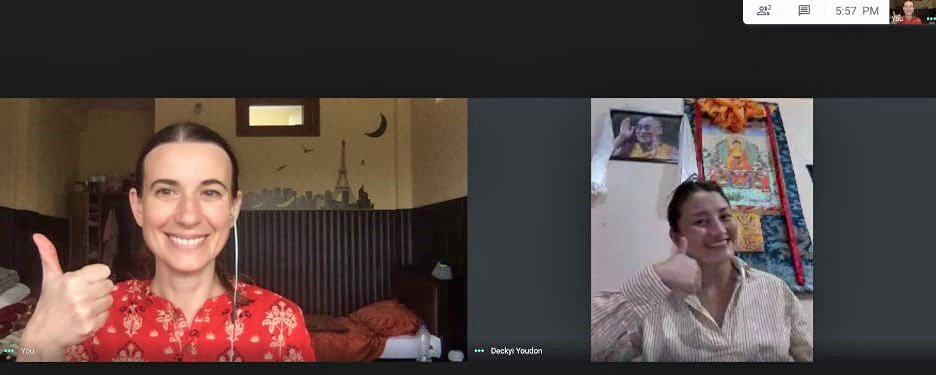
Decky Youdon with one of her students during an online session, December 2020. Photo courtesy of LRZTP.
For more information about the Lotsawa Rinchen Zangpo Translator Program in Dharamsala, Himachal Pradesh, India, visit their website:
http://www.lrztp.org
FPMT.org and Mandala Publications brings you news of Lama Zopa Rinpoche and of activities, teachings, and events from over 160 FPMT centers, projects, and services around the globe. If you like what you read, consider becoming a Friend of FPMT, which supports our work.
- Tagged: gen thupten la, geshe tenzin wangdak, julia wilson, lotsawa rinchen zangpo translator programme
27
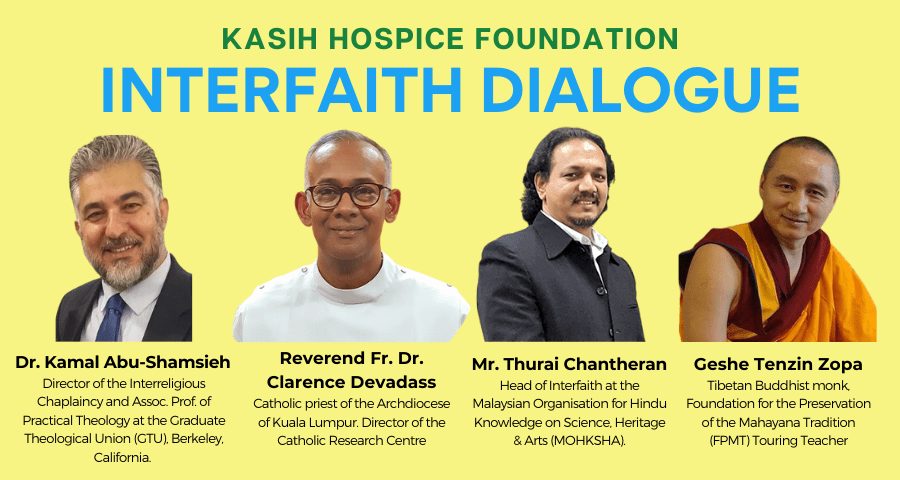
Kasih Hospice Foundation Interfaith Dialogue. Graphic by Dr. Chew Cheng Hoon, Executive Committee board member.
Kasih Hospice Foundation, an FPMT project in Selangor, Malaysia, provides medical, psychosocial, emotional, and spiritual support to people with life threatening diseases such as cancer, HIV/AIDS, and end-stage organ failure, and their families free of cost. Catherine Ooi, general manager, shares the story about the December 5, 2020, Kasih Hospice Foundation Interfaith Dialogue.
Kasih Hospice Foundation, a community hospice based in Klang Valley, Malaysia, held its second Interfaith Dialogue digitally on the platform Zoom. The hospice invited four interfaith speakers and subject matter experts from the Islamic, Christian, Buddhist, and Hindu faiths to speak on “Discovering Faith Perspectives on End-of-Life Care.”
The two-and-a-half-hour session provided a succinct view of what comprises “a good death” from each religion’s perspective. It also helped clarify theological rationales for certain rules or established practices, and how certain framing or understandings of them might be more helpful than others. It ended with the experts’ personal views on end-of-life care and death.
The first part of our Interfaith Dialogue consisted of talks by our four invited speakers. The respective speakers were the Honorable Geshe Tenzin Zopa, touring teacher from the Foundation for the Preservation of Mahayana Tradition (FPMT), who joined us from Australia; Professor Dr. Kamal Abu-Shamsieh, director of Interreligious Chaplaincy at the Graduate Theological Union in Berkeley, California; Reverend Father Dr. Clarence Devadass of the Archdiocese of Kuala Lumpur, director of the Catholic Research Centre, Malaysia; and Mr. Thurai Chantheran, head of Interfaith at the Malaysian Organization for Hindu Knowledge, Science, History, and Art (MOKSHA.)
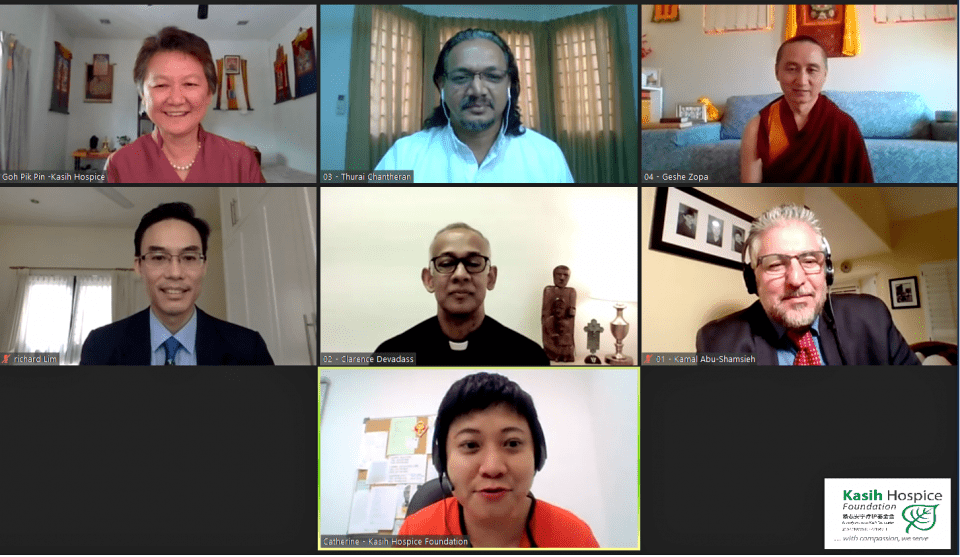
Interfaith Dialogue, Kasih Hospice Foundation, Selangor, Malaysia, December 2020. Photo courtesy of Kasih Hospice Foundation.
More than 2,000 participants from seven countries attended Kasih’s Interfaith Dialogue live over Zoom as well five social media platforms. A simultaneous live translation into Mandarin was enabled via a partnership with the Taitung Foundation Inc., which attracted some 500 viewers to the livestream on its Facebook channel.
In the second part of our Interfaith Dialogue, we invited Dr. Richard Lim, national advisor of Palliative Care to the Ministry of Health, Government of Malaysia, to give the public his perspective on psychosocial and spiritual care in end-of-life care as well as palliative care, and the place spirituality plays within it. We concluded with a one-hour question and answer session.
Watch “Interfaith Dialogue 2020” on the Kaish Hospice Care YouTube channel:
https://youtu.be/QmGUSySeDXY
Kasih Hospice Foundation prioritizes psychosocial and spiritual education as well as medical caregiving as a core competency in making sure families have the skills, knowledge, and—equally important—confidence and reassurance to care for their loved ones at home. As a multicultural, multi-religious country, with diverse medical teams, patient families, staff, and volunteers hailing from every ethnic group and nationality, we believe in the importance and urgency of Interfaith Dialogues that serve to elevate and encourage the principles of universal compassion.
To learn more about Kasih Hospice Foundation, visit their website:
https://www.kasihfoundation.org/
Subscribe to the Kasih Hospice Foundation tri-annual newsletter:
https://mailchi.mp/b92970f8e511/khf-newsletter-02-2020
FPMT.org and Mandala Publications brings you news of Lama Zopa Rinpoche and of activities, teachings, and events from over 160 FPMT centers, projects, and services around the globe. If you like what you read, consider becoming a Friend of FPMT, which supports our work.
- Tagged: catherine ooi, Geshe Tenzin Zopa, kasih hospice
18
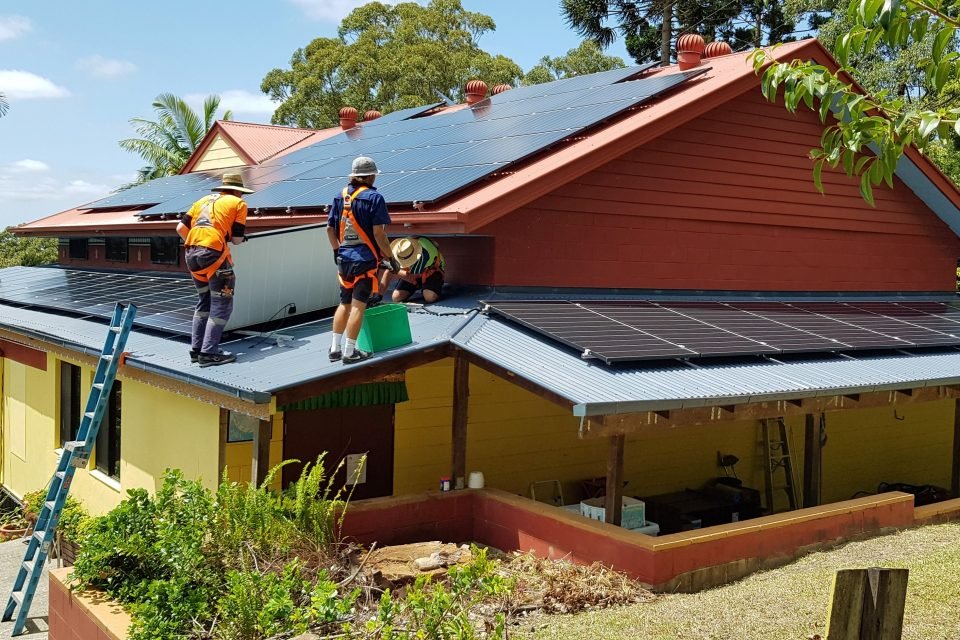
REA Solar crew members completing installation of the solar power system panels on the gompa, Chenrezig Institute, Eudlo, Queensland, Australia, December 2020. Photo by Marc Talloen.
Chenrezig Institute, an FPMT center in Eudlo, Queensland, Australia, has installed a 22 kilowatt (kW) solar power system on the center’s gompa roof to power some of the center’s electricity needs. Marc Talloen, project manager, Interim Executive Committee, shares the story.
In late November and early December 2020, the Chenrezig Institute gompa and its surroundings were buzzing with exciting activities! In a span of a few weeks we installed a solar power system on the gompa’s roof, started the second phase of the inspiring Nalanda Masters Garden, and made significant improvements to Chenrezig Institute’s roads.
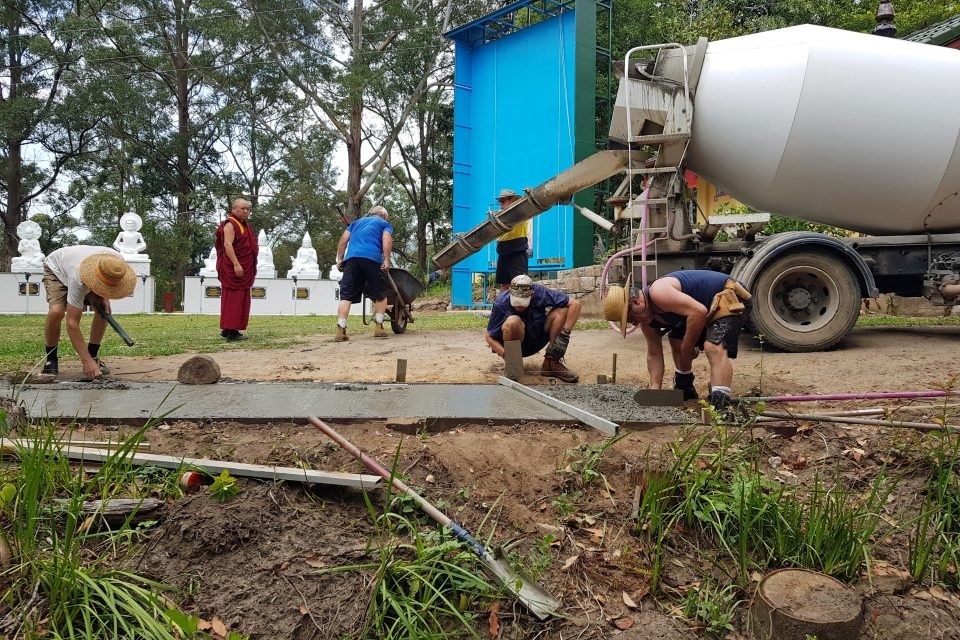
Garrey Foulkes, Geshe Phuntsok Tsultrim, Colin Crosbie, the truck driver, Kym Bartlet, and Ricciardo Ferrari building a reinforced concrete slab in the Nalanda Masters Garden, Chenrezig Institute, Eudlo, Queensland, Australia, November 2020. Photo by Marc Talloen.
A few months earlier, on His Holiness the Dalai Lama’s 85th birthday, Geshe Phuntsok Tsultrim, our FPMT resident geshe, officially inaugurated and consecrated the magnificent Nalanda Masters Garden. The event took place in the presence of Kyabje Lama Zopa Rinpoche, who joined us on Zoom, bestowing his blessings on the new statues in the garden and the community. The opening of the garden inspired a flurry of building activity!
The garden was initially dedicated to a group of eight Nalanda masters. However, as a result of the excitement at the opening ceremony, that plan has changed. We are now working towards completing a set of statues of all seventeen Nalanda masters, as well as a Kadampa stupa and more.
A team of dedicated volunteers are engaged in the preparations needed for phase two of the Nalanda Masters Garden and have included a fancy sitting area under the Bodhi tree overlooking the statues and gompa. A team of avid gardeners brought the Garden of Enlightenment to its full splendor.
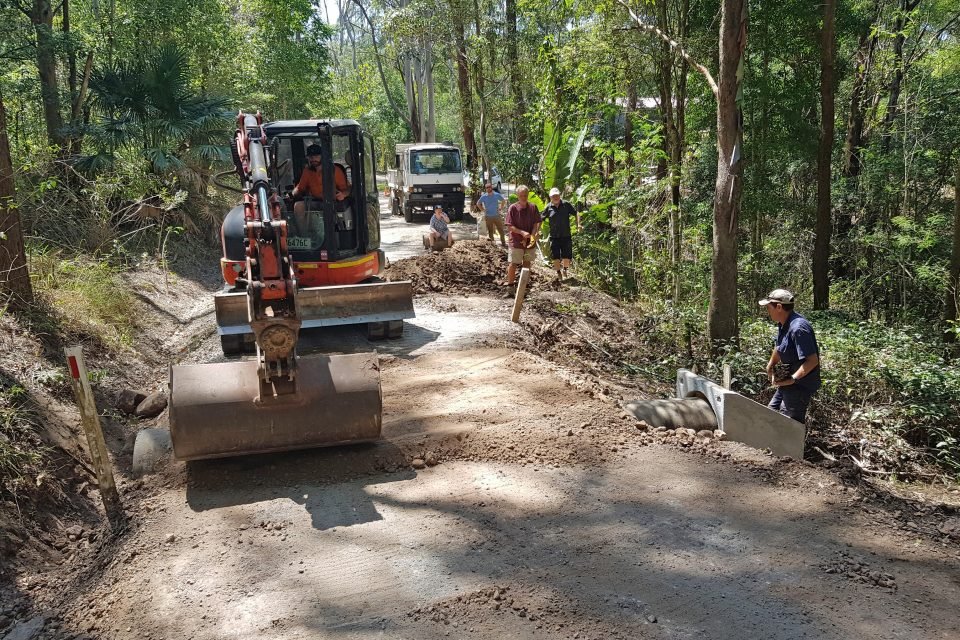
Kym Bartlet, Gordon Noble, and Colin Crosbie finishing the installation of a new and bigger water drain before paving the road, Chenrezig Institute, Eudlo, Queensland, Australia, November 2020. Photo by Marc Talloen.
Partial road improvement projects—including installation of multiple underground cross-road drains and the concreting of an 152 meter (499 feet) erosion prone stretch of Chenrezig Institute’s main entrance road—have been completed. The road re-opened on December 3, just in time for Lama Zopa Rinpoche’s birthday celebrations. We were then ready to cope with abundant rainfall during the December and January rainy season.
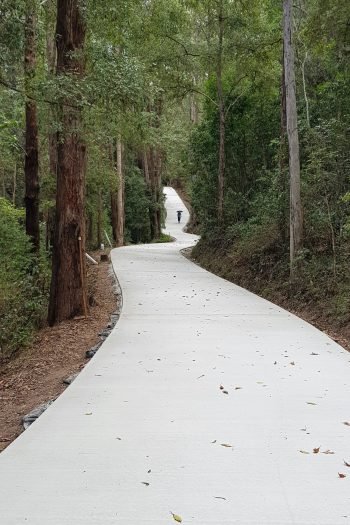
The section of Chenrezig Institute’s newly-paved main entrance road, Eudlo, Queensland, Australia, December 2020. Photo by Marc Halloen.
We had been looking into the potential benefits of installing a solar power system on the gompa roof for quite some time. We figured that if we installed a solar power system with a capacity of 22 kW then we should be able to generate enough solar energy during the daytime to cover electricity needs for most of the gompa, entire Sangha living area (about ten people), and the accommodation facilities for about twenty retreatants!
Adding a Tesla Powerwall 2 battery to our solar power system would allow us to store energy generated by the solar power system so that we could buffer the energy supply during times of passing clouds and use solar power during the first hours after sunset. The battery would also serve as a back-up power supply to the gompa during power outages. These outages are not uncommon in this area and can be attributed to random weather events.
Generous donations allowed us to move quickly and begin ample preparations. In November, we started clearing trees and trimming bushes to allow copious sunlight to sprawl over the gompa roof.
In late November, a team from REA Solar, a solar energy company in Queensland, came to partially install the solar power system, including roof racking, Enphase micro-inverters, all of the cabling, a new electrical switch board, and the battery. The Brisbane harbor has slowed down due to COVID, and so we had to wait patiently for customs to clear the new 465 watt solar modules and be delivered.
Magically, on December 2, the REA Solar team came back to install all modules, and then we were able to test and commission our new solar power system that afternoon.
And so very auspiciously, on December 3—Lama Zopa Rinpoche’s birthday—we achieved our first full day of solar energy generation, producing 134 kilowatt hours (kWh) of solar energy and largely covering that day’s electricity consumption. Of the 114 kWh consumed in that first twenty-four hour period, only 12.70 kWh came from the grid while 101.30 kWh came from the solar power system! An extra 31.90 kWh was exported to the grid.

Tesla phone app used by Chenrezig Institute staff to monitor the center’s electricity consumption and production. Graphs from left to right: 1 – levels of electric power consumed in twenty-four hours from the gompa electric network, 2 – levels of solar energy produced that same day by the gompa solar system, 3 – excess electricity produced by the gompa solar system fed to the battery (below the line) and electricity consumed from the battery when there isn’t enough solar available (above the line), 4 – utility network electricity consumed when no solar or battery energy is available (above the line), or fed back to the utility electric grid when excess solar energy is produced and the battery is already full, 5 – a combined graph showing when solar is available during the day, how it is consumed, and how excess is fed to the grid or stored in the battery, December 2020. Photo by Marc Talloen.
Encouraging results show that in those first three weeks the new solar power system helped us reduce grid electricity consumption by 86.13%. We are confident that we will experience continuous substantial savings, lowering our center’s operational costs for many years to come. By reducing our consumption of fossil fuel-generated energy and minimizing our carbon footprint, Chenrezig Institute is making a great leap into a greener future!
We take this opportunity to thank our generous donors who have helped us realize these projects. Please have a look at the video we have put together, showing the solar power system installation and some of our other recent projects.
Watch the two-minute video “Chenrezig Institute is going solar” on the Chenrezig Institute YouTube channel:
https://youtu.be/ebPVD3KCzJM
We have further renovation and upgrading projects planned, including renovating the Lotus House retreat accommodation, adding a new amenity block, an additional solar power energy system, and adding a new 3 phase electricity supply circuit to the Big Love Café so we can supply it with solar energy.
For more information about Chenrezig Institute, visit their website:
https://www.chenrezig.com.au/
FPMT.org and Mandala Publications brings you news of Lama Zopa Rinpoche and of activities, teachings, and events from over 160 FPMT centers, projects, and services around the globe. If you like what you read, consider becoming a Friend of FPMT, which supports our work.
12

Losang Dragpa Centre 25th Anniversary Celebration. Graphic by Gavyn Teh.
On December 10, 2020, Losang Dragpa Center (LDC), the FPMT center in Petaling Jaya, Selangor, Malaysia, celebrated their twenty-fifth anniversary. The center shares the story.
On the auspicious Lama Tsongkhapa Day, LDC broadcast the e-celebration of its twenty-fifth anniversary via Zoom, Facebook, and YouTube, reaching out to teachers, Sangha, members, and friends from near and far. An in-person 25th Anniversary Celebration was initially planned for two years ago, but COVID made it necessary to rely on new technology to go virtual. That turned out to be a blessing as many more people were able to participate.
LDC began with a few members in 1995, in a rented link-house that was the home of co-founder Huei in Ampang. Soon after, a bank loan was obtained to purchase a semi-detached bungalow for center activities. These two Ampang houses served as LDC for its first eight years. LDC eventually moved across town to Jalan Birah and was finally able to acquire its own (current) premises with a beautiful garden located in a quiet residential area in Petaling Jaya, Selangor.
Looking back at LDC’s activities over the past twenty-five years, we are happy to have been able to abide by Kyabje Lama Zopa Rinpoche’s advice and the FPMT’s Five Pillars of Service:
- Dharma: LDC offers Dharma classes for adults at the introductory level and the FPMT Basic Program.
- Universal Education for Compassion and Wisdom: The principles of the 16 Guidelines for Life underscore LDC’s “Dharma for Kids” program (five to twelve year-olds) and inspired the teens program (thirteen to sixteen year-olds) called “10 For Good” which is specifically based on the ten virtues.
- Social/Community Service: LDC was the mother of the now separately registered but hugely successful Kasih Hospice. Today, LDC responds to community needs such as Aunty Mee Fah Animal Shelter and food donation to the poor (during the pandemic) through its adult, teen, or children’s projects.
- Interfaith Activities: A Buddhist relic exhibition was organized and the spiritual leaders of Christian and Hindu organizations, along with leaders of other Buddhist traditions, were invited to the event and were also invited to speak at the opening ceremony.
- Revenue generation activities: LDC’s Dharma programs are offered on a free of charge basis but generates revenue through its Dharma Shop and fundraising activities throughout the year, during Vesak/Saka Dawa, the four great holy days of the Buddhist calendar, and Lama Tsongkhapa Day activities, offering the public opportunities to sponsor altar offerings and participate in pujas.
For any Dharma center, achieving twenty-five years of activities requires commitment and heart. We are forever indebted to our precious Guru Kyabje Lama Zopa Rinpoche and all our other gurus, seven past and present FPMT resident teachers, and their translators. The contributions and sacrifices made by members, benefactors, volunteers, and executive committee members also cannot be forgotten and are deeply appreciated.
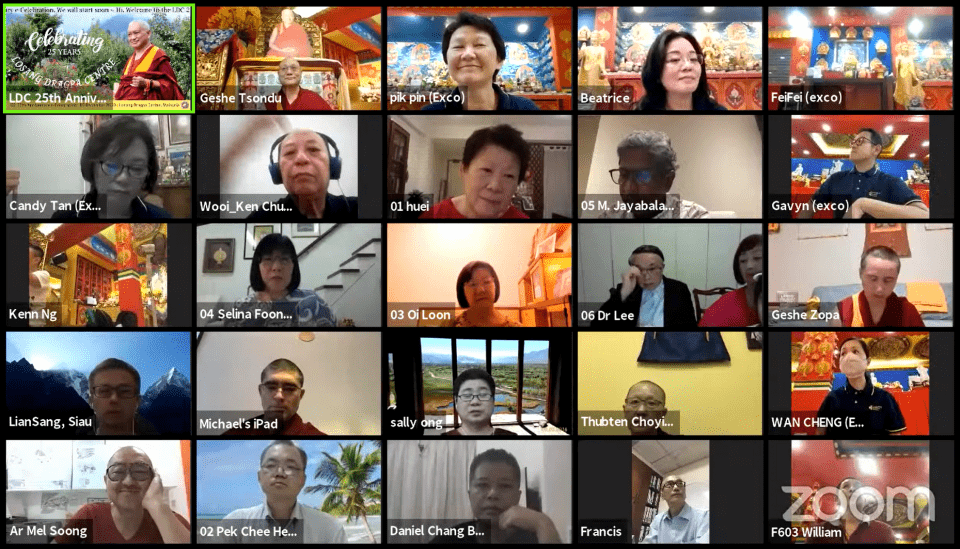
25th Anniversary Celebration on Zoom, Losang Dragpa Centre, December 2020. Photo by Dr. Chew Cheng Hoon, LDC member.
The 25th Anniversary Celebration featured a trip down memory lane of LDC’s history via a five-minute video “LDC’s 25 years Journey.” The high points of the night were the greetings and advice from our Guru Kyabje Lama Zopa Rinpoche and Khen Rinpoche Geshe Chonyi, as well as words of sharing and wisdom from past resident teacher Geshe Tenzin Zopa and Sangha translators Ven. Michael Losang Yeshe and Ven. Tenzin Sherab. The event also relayed personal greetings from co-founders Huei and Pek Chee Hen who are trustees of LDC, followed by fellow trustees Lee Oi Loon and Selina Foong (who also serves as FPMT Southeast Asia regional coordinator), and two past center directors, Datuk M. Jayabalan and Dr. Lee Hock Bee.
The biggest big surprise of the night was sprung by LDC’s current FPMT resident geshe, Geshe Jampa Tsondu, who has been at the center since 2012. Geshe Jampa Tsondu read his three-minute twenty-fifth anniversary greetings out loud fully in English. This was met with appreciation and applause from members and students!
Watch “(#GoLive) FPMT LDC 25th Anniversary Celebration” on the FPMT LDC YouTube channel:
https://youtu.be/9fjpb4r_WFw
LDC maximized the auspiciousness of Lama Tsongkhapa Day by launching the center’s new mobile-friendly website fpmt-ldc.org.
Geshe Jampa Tsondu said in his speech, “Twenty-five years is not long but not short either.” He said we should build on what we have already accomplished and continue to strive in the Dharma and its activities to benefit all.
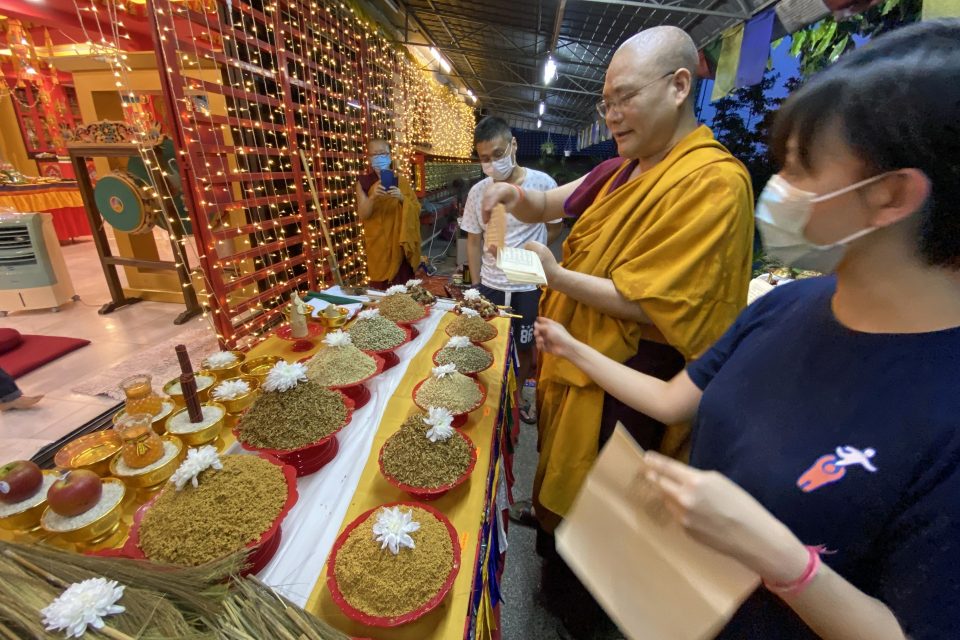
Ven. Thubten Choying, Kenn Ng, Geshe Jampa Tsondu, and Lua Chiew Fei making offerings before the Yamantaka Pacifying Fire Puja, Losang Dragpa Centre, Selangor, Malaysia, December 2020. Photo by Gavyn Teh.
As a token of appreciation to all, LDC has released a recording of the Migtsema prayer composed into a song by a local artist. The recording features chanting by Geshe Jampa Tsondu and Kenn Ng, LDC’s translator.
Listen to “MIGTSEMA – LDC 25th Anniversary Celebration” on SoundCloud:
https://soundcloud.com/fpmt-ldc/migtsema-ldc-25th-anniversary-celebration
LDC center director Dato’ Dr. Goh Pik Pin, alongside her executive committee, took this opportunity to thank everyone who attended the 25th Anniversary Celebration for their support with hopes for many awesome years to come.
To learn more about Losang Dragpa Centre, visit their new website:
http://fpmt-ldc.org/
Lama Zopa Rinpoche is the spiritual director of the Foundation for the Preservation of Mahayana Tradition (FPMT), a Tibetan Buddhist organization dedicated to the transmission of the Mahayana Buddhist tradition and values worldwide through teaching, meditation and community service.
- Home
- News/Media
- Study & Practice
- About FPMT Education Services
- Latest News
- Programs
- New to Buddhism?
- Buddhist Mind Science: Activating Your Potential
- Heart Advice for Death and Dying
- Discovering Buddhism
- Living in the Path
- Exploring Buddhism
- FPMT Basic Program
- FPMT Masters Program
- FPMT In-Depth Meditation Training
- Maitripa College
- Lotsawa Rinchen Zangpo Translator Program
- Universal Education for Compassion & Wisdom
- Online Learning Center
- Prayers & Practice Materials
- Overview of Prayers & Practices
- Full Catalogue of Prayers & Practice Materials
- Explore Popular Topics
- Benefiting Animals
- Chenrezig Resources
- Death & Dying Resources
- Lama Chopa (Guru Puja)
- Lama Zopa Rinpoche: Compendium of Precious Instructions
- Lama Zopa Rinpoche: Life Practice Advice
- Lama Zopa Rinpoche Practice Series
- Lamrim Resources
- Mantras
- Prayer Book Updates
- Purification Practices
- Sutras
- Thought Transformation (Lojong)
- Audio Materials
- Dharma Dates – Tibetan Calendar
- Translation Services
- Publishing Services
- Teachings and Advice
- Find Teachings and Advice
- Lama Zopa Rinpoche Advice Page
- Lama Zopa Rinpoche: Compendium of Precious Instructions
- Lama Zopa Rinpoche Video Teachings
- ༧སྐྱབས་རྗེ་བཟོད་པ་རིན་པོ་ཆེ་མཆོག་ནས་སྩལ་བའི་བཀའ་སློབ་བརྙན་འཕྲིན།
- Podcasts
- Lama Yeshe Wisdom Archive
- Buddhism FAQ
- Dharma for Young People
- Resources on Holy Objects
- Ways to Offer Support
- Centers
- Affiliates Area
- Teachers
- Projects
- Charitable Projects
- Make a Donation
- Applying for Grants
- News about Projects
- Other Projects within FPMT
- Support International Office
- Projects Photo Galleries
- Give Where Most Needed
- FPMT
- Shop
Subscribe to FPMT News
Translate*
*powered by Google TranslateTranslation of pages on fpmt.org is performed by Google Translate, a third party service which FPMT has no control over. The service provides automated computer translations that are only an approximation of the websites' original content. The translations should not be considered exact and only used as a rough guide.When we study Buddhism, we are studying ourselves, the nature of our own minds






